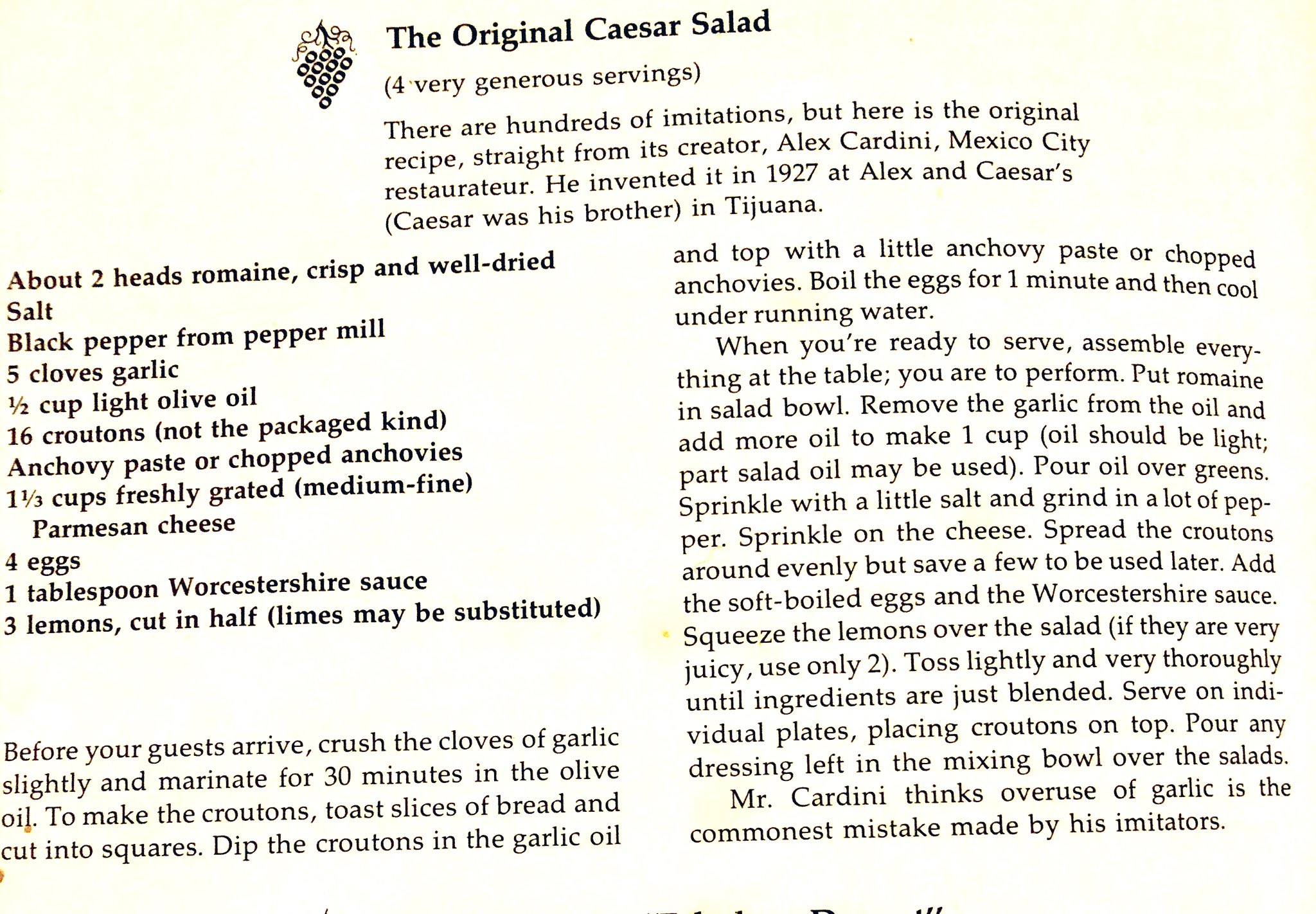Every restaurant in Las Vegas would be a steakhouse if it could be. – EATING LAS VEGAS – The 52 Essential Restaurants
It’s hard not to have a soft spot for the American steakhouse. What began in the beer halls and speakeasies of New York City over a hundred years ago (e.g., Palm, Keen’s, Peter Luger, et al) has morphed into the most expensive of restaurant genres, where checks north of $150/pp are now as common as overpriced California cabernets.
Nothing sells here like steaks. Beef, it’s what’s for dinner, and as a class, Vegas steakhouses outperform other restaurants by whopping margins. If the baseline for a successful Strip eatery is $1,000,000/month in sales, it’s a fair bet that most major meat emporiums exceed that by at least 50%.
So, it’s no wonder our post-Covid restaurant recovery is being led by steakhouses. Hunks o’ prime steer muscle and a formulaic menu are the surest way to fill your dining room, and packed they are…from Summerlin to Las Vegas Boulevard South. Even with the price of beef being through the roof, people are spending faster than drunken sailors on shore leave. Quite frankly, the crowds of free-spending carnivores cramming these places has flummoxed even an old restaurant pro like yours truly. “Where is all this pent-up passion for prime (not to mention cash) coming from?” he thinks to himself as he sees the bodies pressed four-deep at the hostess stand…on Tuesday nights!
Chefs will tell you profit margins on steaks are very low. But there’s something about the beefy vibe that encourages the copious ingestion of booze — from vodka martinis to trophy wines — and when people want to drink, the Vegas steakhouse is here for them.
The point is, the formula for all of these joints is as predictable as a rom-com plot. They all get the same groceries, so all that’s left is how well they tweak them.
These days, everyone features the same 9-10 steak cuts from similar purveyors, letter-box “wagyu” beef that is now about as special as tuna fish, and the same old-same old sauces and sides. (Robuchon potatoes? Check. Shellfish tower? Double your check. Roasted veggies anyone?)
None of this predictability deters anyone from flocking to these restaurants — which, this being America, may be the point.
With all this in mind, we thought we’d take a look at four major players (two newbies and two old souls) to give you a sense of what you’re up against these days.
Harlo burst on the scene barely six months ago and immediately flipped the script on Andiron, its predecessor steakhouse in the space. The front door is now where the backdoor used to be, and what was once open, bright and airy (trying to mimic something swanky and Southhampton) is now dark, cozy and clubby.
The bar also shifted….in more ways than one.
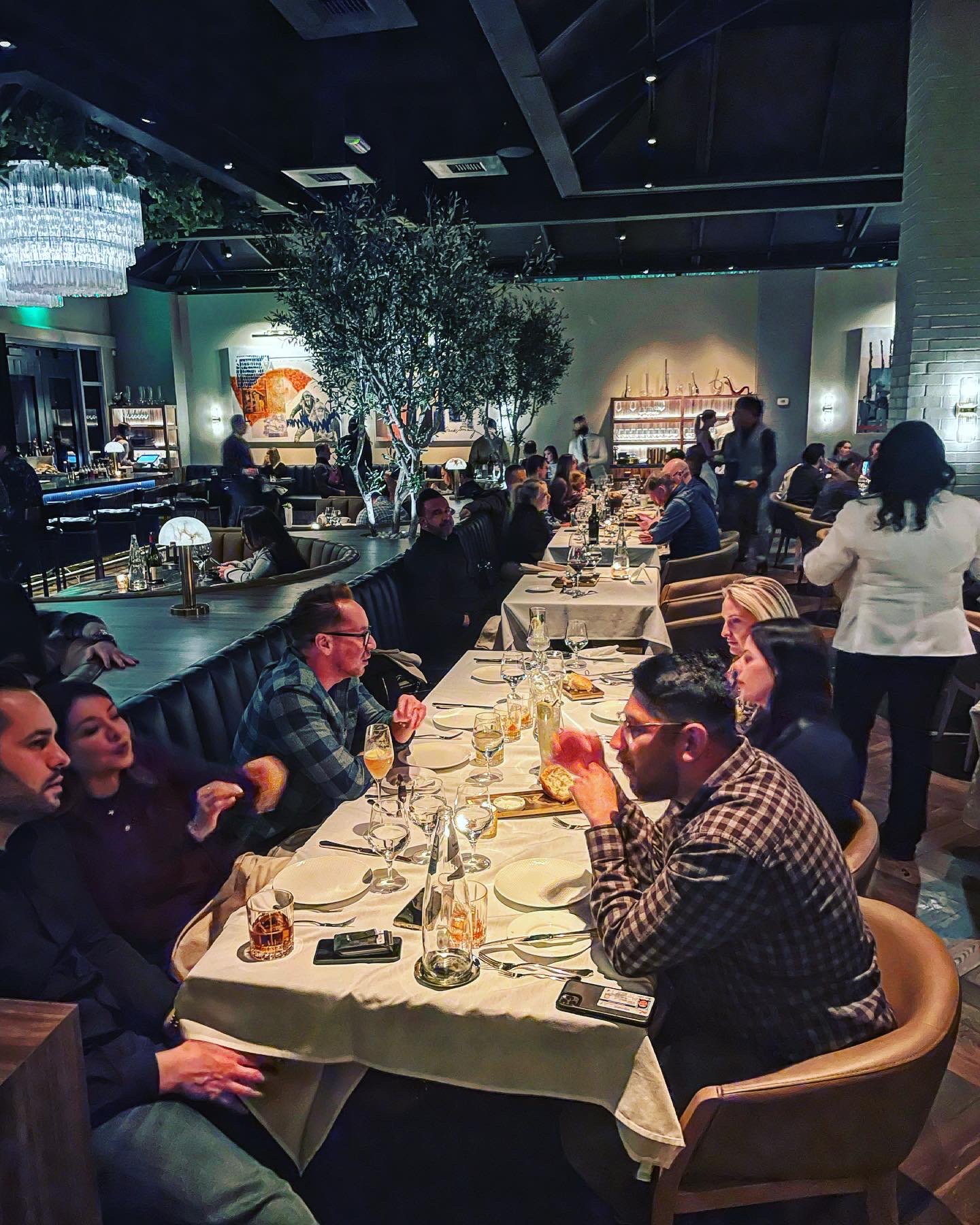
There is big real estate money behind this project; real pros in the kitchen; and the house is managed by long-time Strip front-man Ivo Angelov (whose loyal following probably accounts for a half of the customers).
Put it all together and you have the kind of out-of-the-gate hit of which most restaurateurs can only dream. It doesn’t hurt that it is the only decent steakhouse for ten-miles, and that Las Vegas’s toniest neighborhoods are all within a fifteen-minute drive. But Andiron had these same advantages and struggled to find its footing (even pre-Covid). Finding itself will not be a problem for Harlo; finding a seat on weekends will be.
Once you’re seated, you can expect the standard cuts and sides, here priced at or above similar fare on the Strip — and when we say, “at or above” we’re not kidding. Prices here have been set without apology and with the confidence (arrogance?) of someone who knows his audience won’t blink at $30 apps and $80 steaks. Fleming’s this is not.
We passed on the seafood tower, instead settling for some very good oysters ($26) served with a compelling yuzu-soy mignonette that made us forget about the excellent cocktail sauce beside it. (By way of price comparison, at Carversteak, thirteen miles east, the shellfish extravaganza is $165; here it clocks in at $175. So much for the Strip being “too expensive.”)

From there it was on to a smallish, blandish steak tartare ($20) — the only “meh” of the meal — and three Flintstonean shanks of marrow ($30) that would easily serve a table of four. So dense with flavor were the garnishes for the marrow — port wine onions and oxtail jam on toast — they could constitute a meal all their own.
The Caesar ($15) had its charms (crunchy anchovy croutons, lots of grated Parm), as did the warm milk bread and butter. All were served at the right temperature, as was the excellent butter. (Frigid salad, less than impeccably fresh bread, and rock hard butter being unforgivable sins at this level, and the banes of our existence.)
As there were only two of us, the main event was slightly truncated…meaning only one protein and a couple of sides hit the table. At eighty-eight bucks, an aged rib eye better deliver the goods, and by and large this one (below) did. Impeccably trimmed and cooked, it was all that is loved about the marbled succulence of this cut.
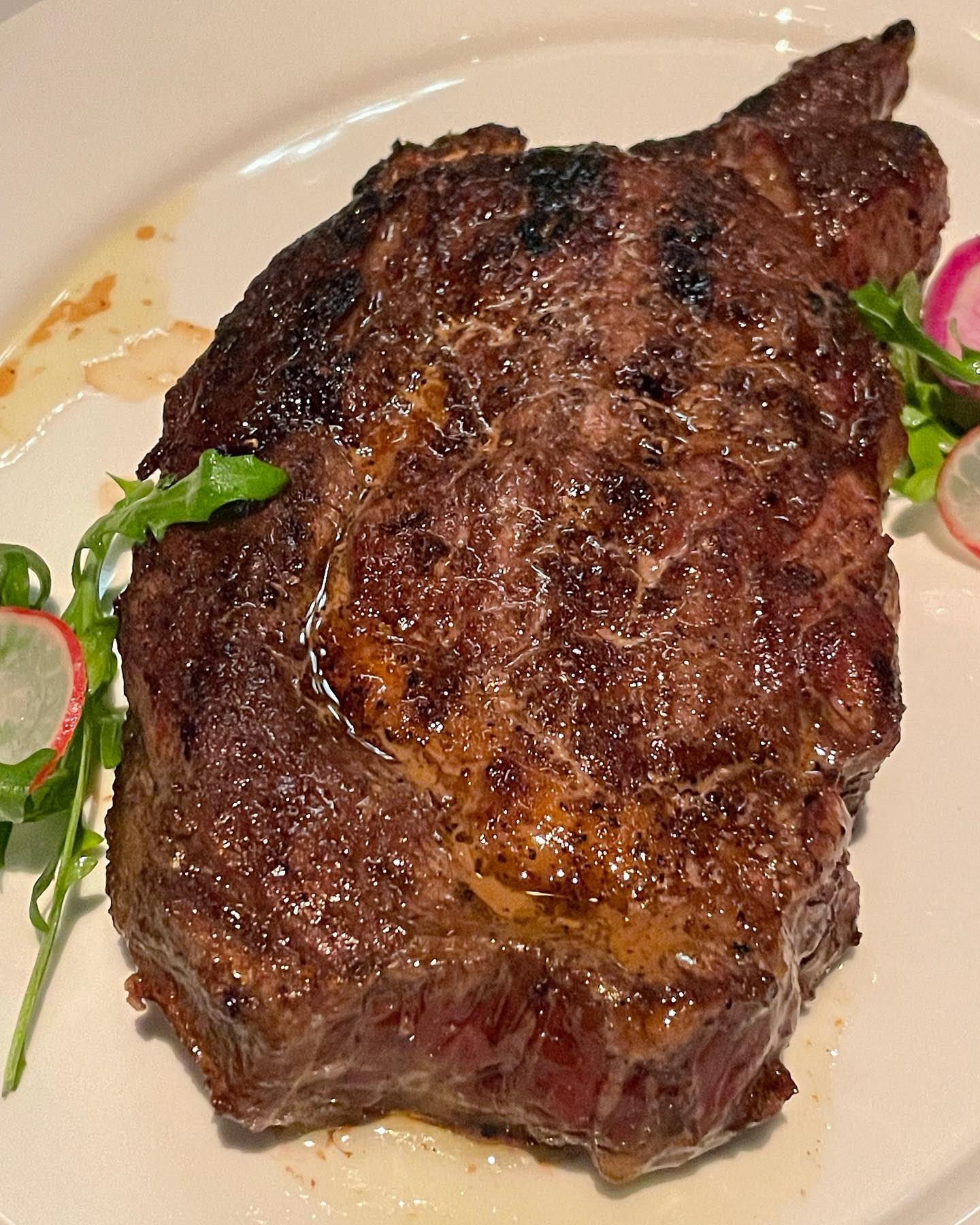
Not really sure what the two-week aging brought to the dance but the beefy flavor was there in spades, even if a certain mineral-rich tang was not. The blistered green beans ($10) and crispy ‘taters ($11) were all that and a bag of almond romesco– the snappy sauce adorning the Phasoleolus vulgaris.
Our biggest surprise of all, though, was reserved for the pasta:

Gina Marinelli is the talent behind these creations, and her rotating cast of pastas will depend on whatever is seasonal the day you arrive. We sprang upon the Spring papardelle with English peas, morels, goat cheese and poppy seeds (above) to see if she was up to her old tricks, meaning: sometimes her pastas go an ingredient too far for our tastes. But this time everything had its place and there wasn’t a flavor wasted. Really spectacular stuff. Worth going for all by itself and enough to make you forget your inner carnivore.
Besides the tariff, Harlo has announced its big-league intentions by hiring a pastry chef — in this case, a young chap named Alberto Rodriguez, who does a panoply of worthy sweets, including a mean Grand Marnier soufflé:
https://twitter.com/i/status/1501736412307095557
They also do the bloated caviar service-thing here (caviar and truffles now running neck-and-neck with “exclusive” Japanese wagyu in the faux luxe sweepstakes), and no shortage of ostentatious spirits for those needing to impress themselves by stupidly combining Louis XIII cognac ($200/shot) with salty fish eggs — one of those things you do because having bad taste isn’t much fun unless you can show off about it.
The wine list is evolving and it isn’t exactly cardiac-inducing, but don’t expect any bargains either. Bottles under a hundy are sprinkled here and there, but the calculation has obviously been made that the landed gentry is now ready to cough up big bucks for bottles. By-the-glass options start at $12 and zoom quickly above $20, topping out at $45 and $65 for “reserve” Cali cabs. That’s sixty-five bucks for a glass. Of wine.
As you can see, Harlo is not for the faint of heart or pocketbook. It is a big-hitter steakhouse with the pedigree and prices to prove it. Direct aim has been taken on a customer base who used to travel many miles for beef and cooking this good. They’re staying closer to home these days, and apparently spending like it’s 2019 again. Only time will tell if Harlo will succeed in out-stripping the Strip, but for the time being, Summerlin’s fat cats now have a steakhouse to call their own.
Our meal was comped and we left a $100 tip, augmented by our dining companion’s $100 tip.
Waiter: How would you like your steak sir?
Me: Like winning an argument with my wife.
Waiter: Rare it is!
Steakhouse quality is so high across the board, searching for the preeminent purveyor of prime is a fools errand. Instead we look for the subtleties that distinguish them, and hope that something stands out. Often, beyond the differences in decor, it does not.
And none of this is by way of criticizing Carversteak. Only to point out how, to set themselves apart, chefs and owners strain mightily to convince you they’re doing something unique, even when they are not. At Carversteak, occasionally they are.
Sometimes you just throw up your hands and admit you have no more shits to give as to whether Carversteak’s “yellowtail sashimi crudo with avocado , serrano chili, ginger-lime ponzu”:
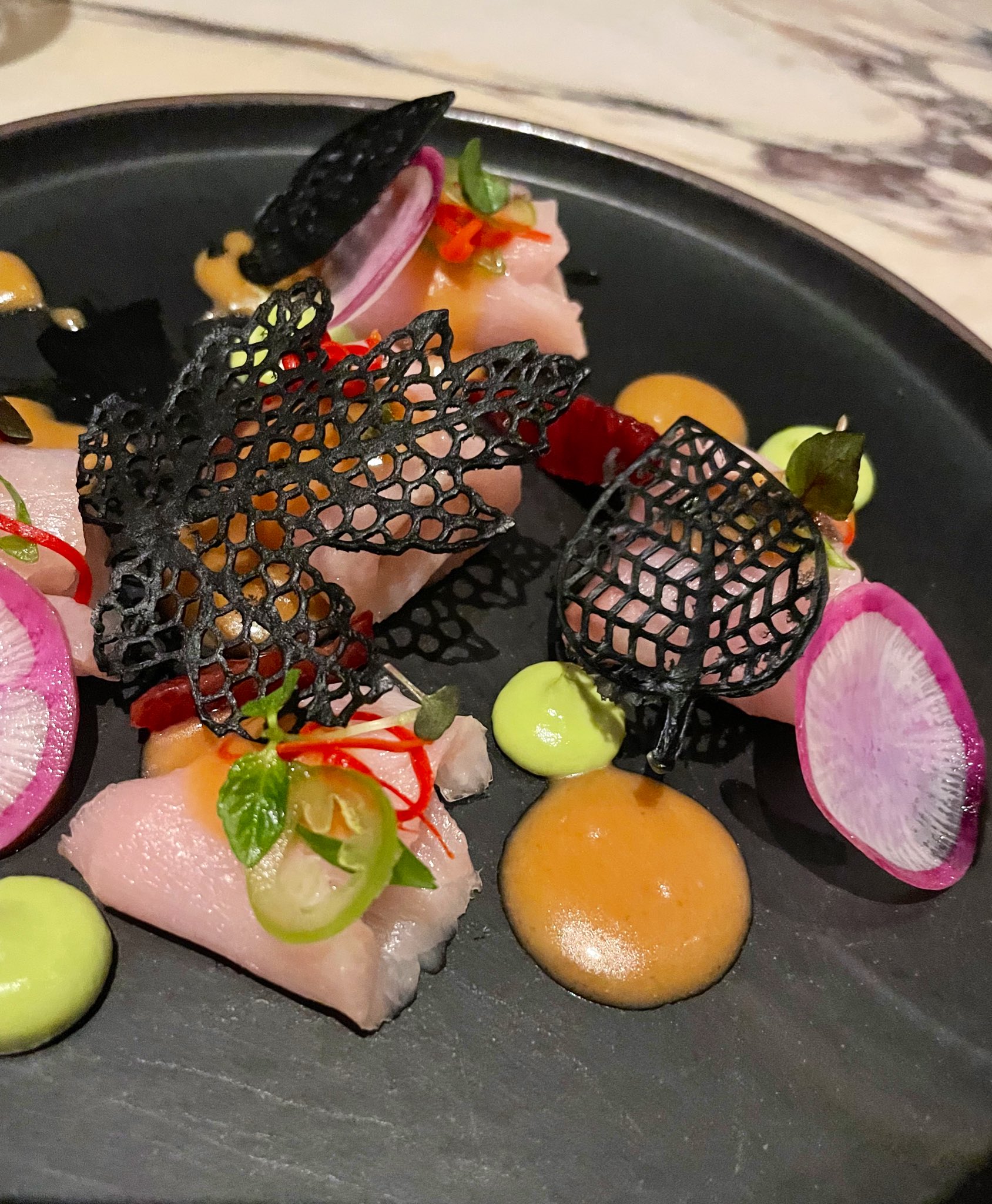
….is all that different from Harlo’s “hamachi crudo with ginger-soy vinaigrette, avocado puree and serrano chili.”
Or take the ubiquitous shrimp cocktail — one might dazzle you with Cajun remoulade (Harlo), while others — Caversteak, Golden Steer, SW et al — stick strictly to the horseradish catechism.
The same thing occurs with side dishes:
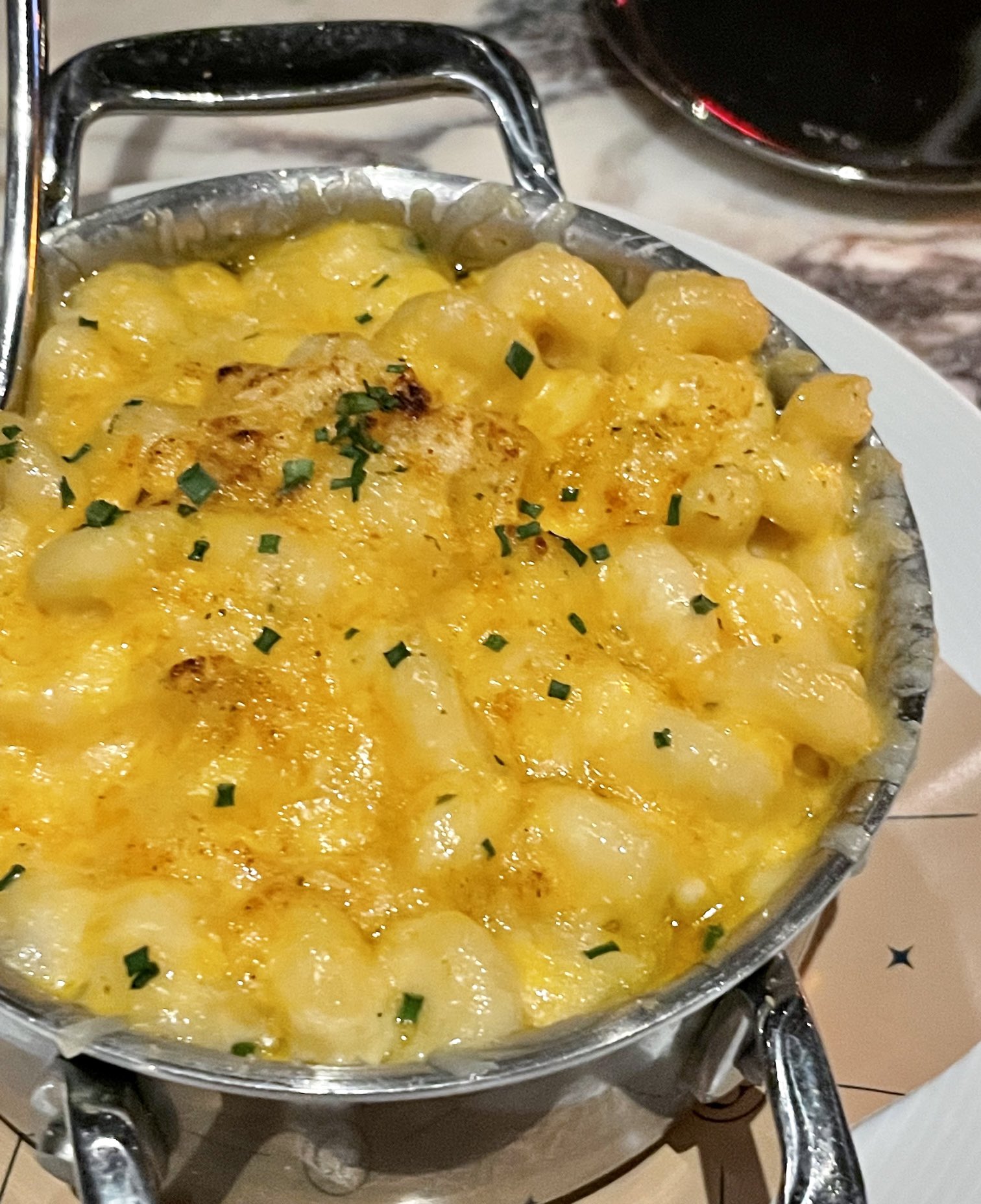
“Oh look honey! They have mac ‘n cheese with aged cheddar!” says you, feigning excitement.
“That’s much better than the mac ‘n cheese with smoked cheddar and gouda, isn’t it?” Said no one ever.
They’re all good, soothing, and cheesy, but basically only minor variations on a theme you’ll find in every steakhouse in Vegas, if not America.
Carversteak does a “baby iceberg wedge” ($19), garnished with an onion ring and a soft-boiled egg. Harlo throws pastrami into the ($16) mix, and tops its lettuce with lavash. (How very unleavened of them!) The Golden Steer keeps it simple and pours on the blue cheese sprinkled with bacon and tomatoes ($10). Is one “better” than the other? Does an onion ring and an egg justify doubling the price? Or are you paying for real estate and decor? Or do you even care?
Where Harlo announces itself as ingredient-driven, here the menu emphasis is recipe-driven — in this case by restaurant vet Daniel Ontiveros — a dude who knows his way around premium proteins.
We didn’t have the “Lobster en Croute” , but at least it is something different. (Cream sauces are back!) Ditto the green goddess “Crudité” — which almost makes hummus wondrous:
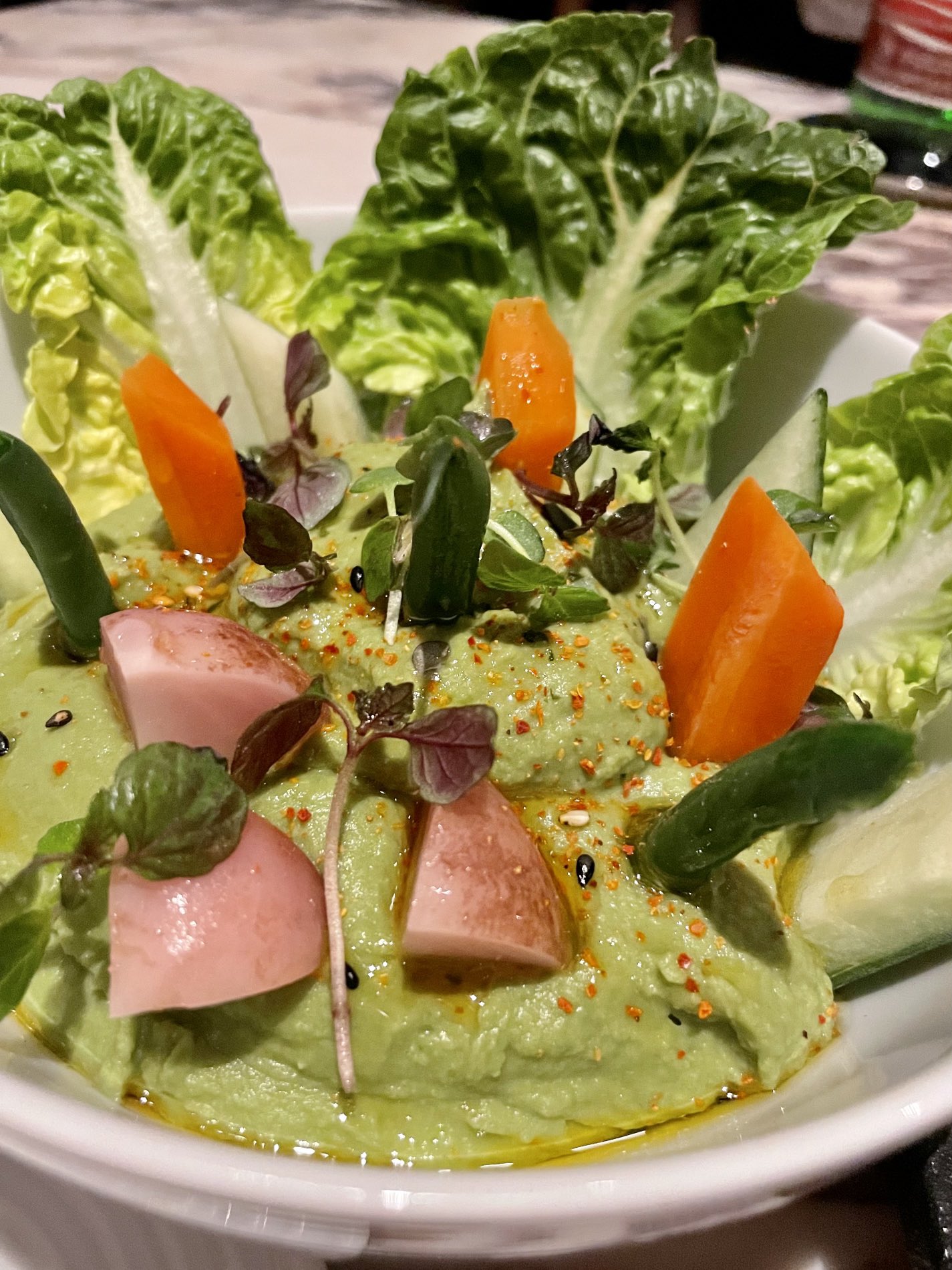
….and a chunky, mayonnaise-y steak tartare (below) that combines creaminess with a kick. Definitely one of the more unforgettable ones we’ve tried….and we’ve tried them all:
Other items which kept our attention included the “Caviar Poppers” (gougères stuffed with lemon-chive crème fraiche), and the previously maligned yellowtail sashimi, that made up for in presentation what it lacked in innovation.
Finally, there were the proteins. Being a two-top our capacity was limited, but the 20 oz. Kansas City strip ($76) claimed to be aged for 28 days and tasted every bit of it.
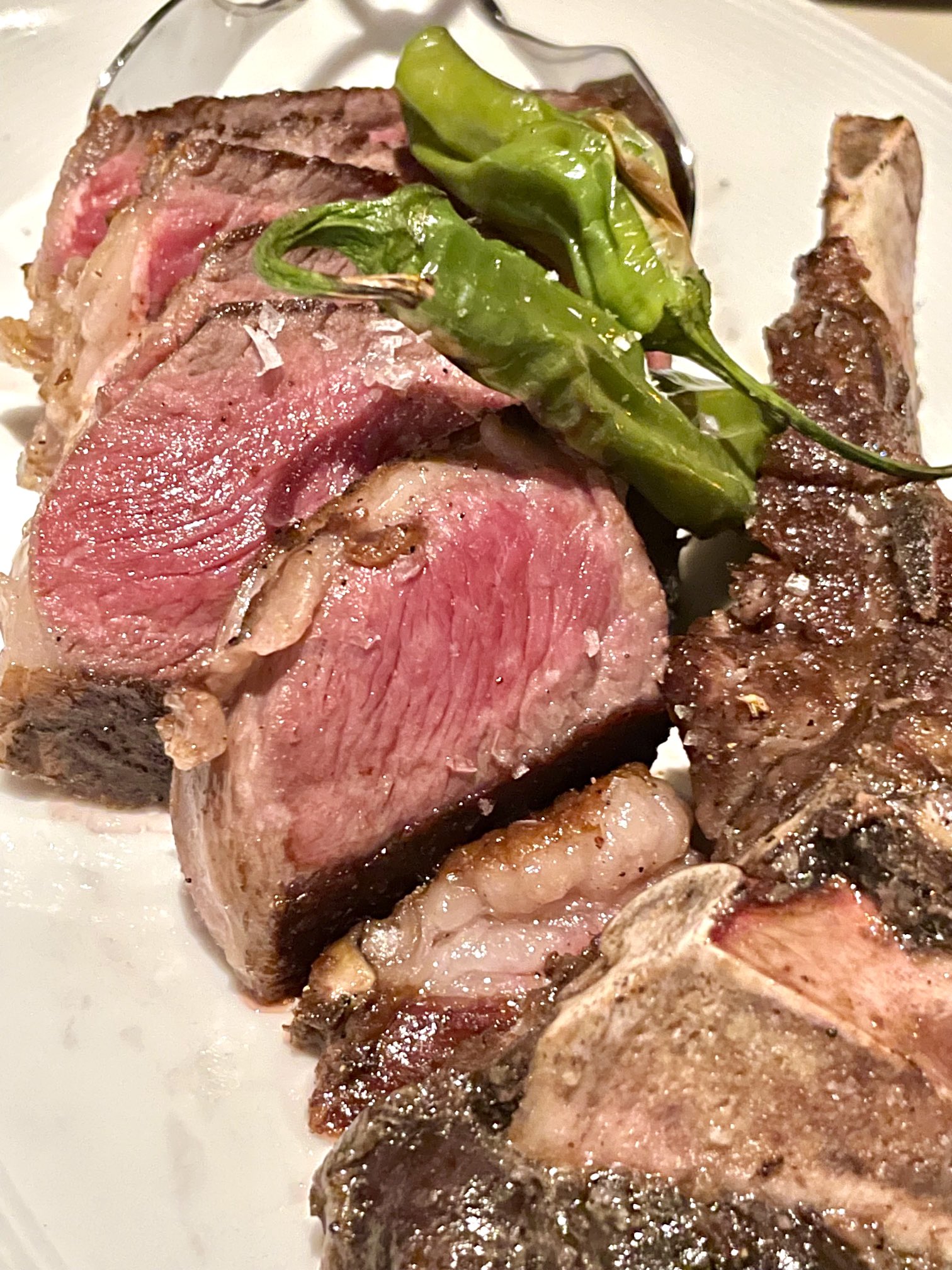
We don’t want to go too far out on a limb here, but of all the boffo beef we’ve had during this two-week steak-out, this one had the deepest, most penetrating flavor. Both sauces (Bordelaise and Peppercorn) were textbook perfect, with the latter disappearing the fastest.
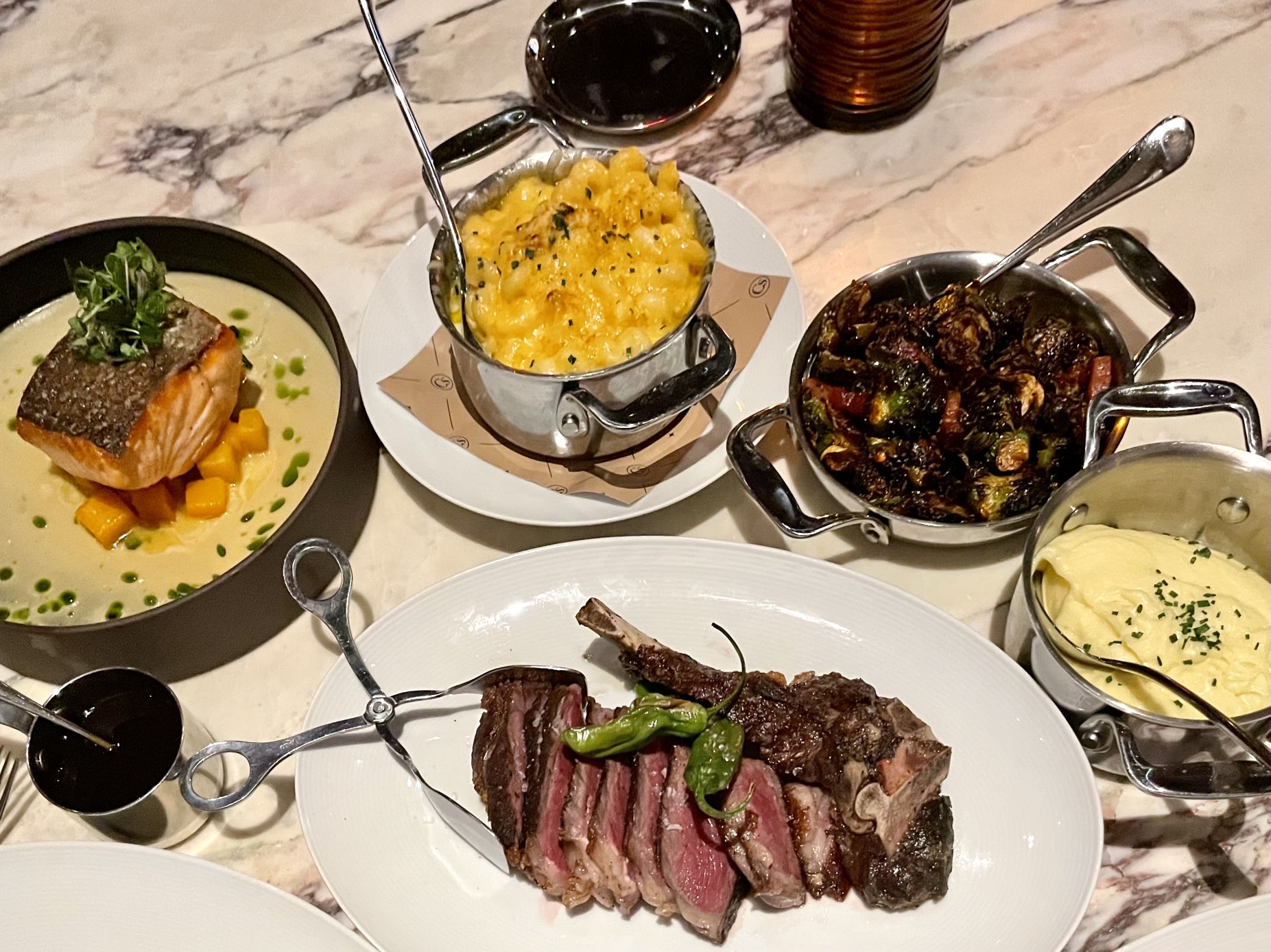
The Food Gal® ordered the salmon (above left), even though doing so should be grounds for divorce anywhere but the Pacific Northwest. To our surprise, as much as we fished for flaws, our critic’s net came up empty. Fresh and firm, it was flawless, right down to the curry broth beneath it. All in all, a nice way to give this over-served, insipid (and often stale-tasting) species a little sass.
Big hitters will no doubt love the Brobdingnagian (42 oz.) Pat LaFrieda Tomahawk, which gets its hefty price tag ($260) from the branding of the beef (cf. Harlo where you get 2 ounces less Flannery Beef for eighty fewer bucks). These humongous cuts are all the rage these days, and make sense for large parties, even if the weight advertised includes the prodigious bone. Regardless, large parties of beefy men take to these things like a college boy to a kegger.
Cocktails are by über-booze maven Francesco LaFranconi, and the wine list won’t cause cardiac arrest. How much better can a steakhouse get?
Our dinner a deux was comped and we left a $120 tip.
We’ve run hot and cold about SW over the years. Two perfunctory wallet-bending meals in a row (over five years ago) had us writing it off forever, and it was only Mark LoRusso taking over the kitchen (after the shuttering of Costa di Mare) that brought us back.
It’s a huge (300+ seats) restaurant that can feel like Grand Central Station on busy nights — which is almost every night of the year. It shows itself best if you’re able to score a seat on the patio, but those fill up fast. As busy as it gets, the noise level remains remarkably conversation-friendly, and the lighting is soft, not-too-low — complimenting the aging Boomer crowd seeking to forget the ravages of time when their hair was dark, their thighs were firm, and they had less chins than a Chinese phone book.
If Harlo is ingredient-focused, and Carversteak full of surprising recipes, SW takes the steak as the cheffiest in the bunch, as LoRusso’s mosaic of raw tuna shows:
If that doesn’t convince you, then perhaps this Snake River Farms carpaccio with balsamic “pearls” will:
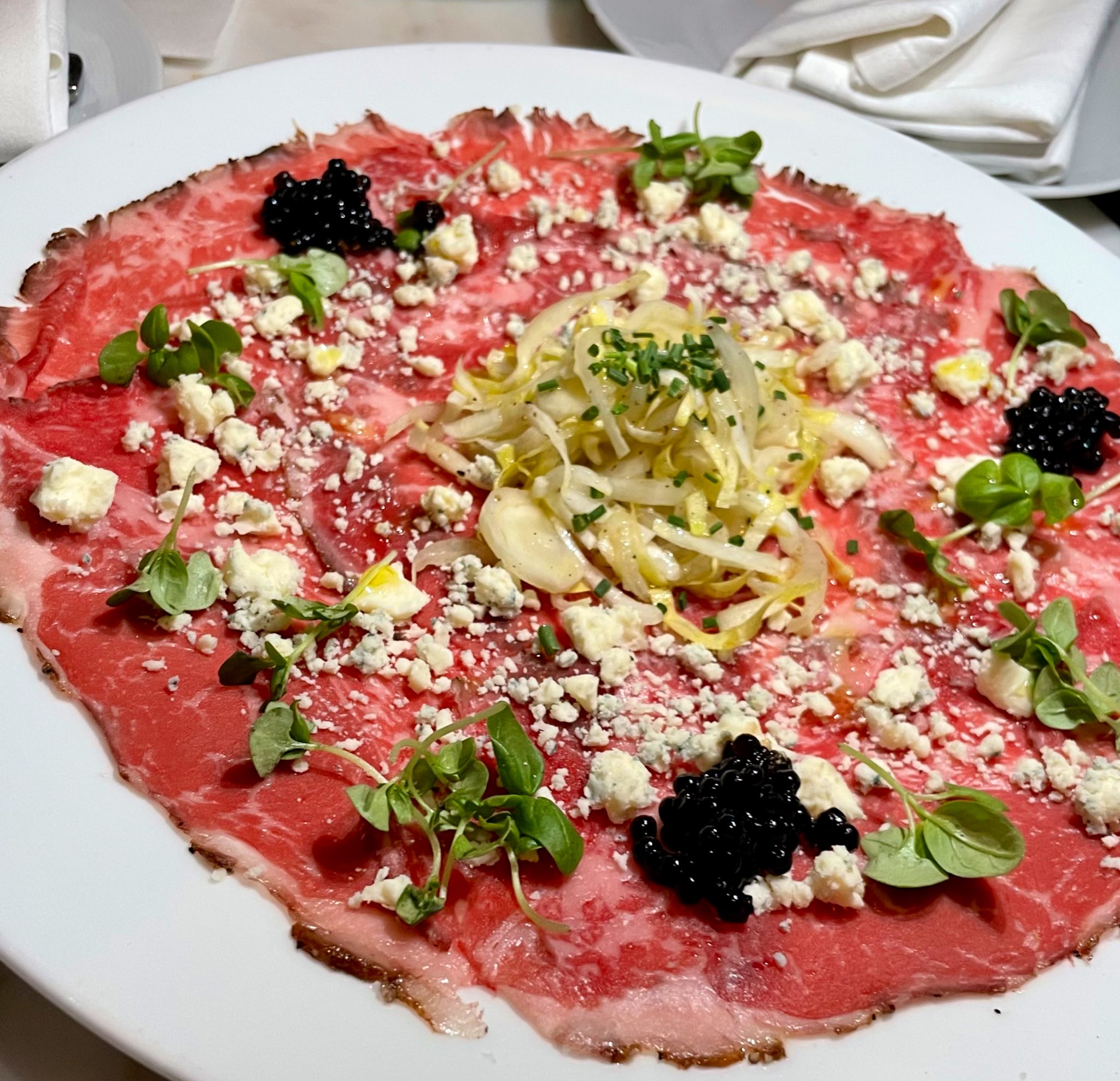
All of this is the domain of Mark LoRusso — unsung hero and former top toque of the shuttered Costa di Mare upstairs — who made the transition from Italian seafood to meat seamlessly. We’ve followed LoRusso’s career since the early 2000s, and everywhere he has moved he has made his mark without fanfare, but with the confidence of a real pro who elevates any kitchen he controls.
When they announced he was taking over SW last year we had no doubt it would up its game and it has, re-invigorating the (previously tired menu with Sardinian lobster gnocchi ($29), Alaskan King Crab ravioli ($24/$48), and a thick with lobster bisque that shows off LoRusso’s seafood chops:
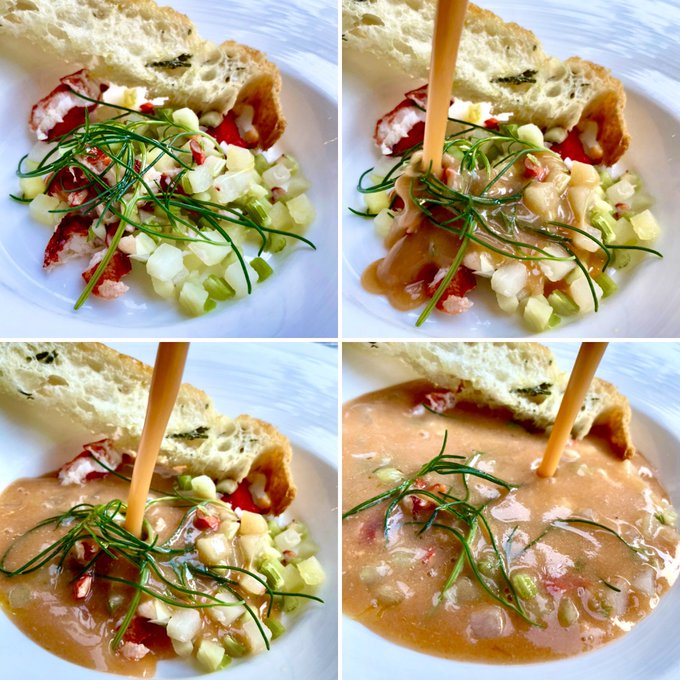
At these prices, you expect the steaks to be perfect and they are. (See the strip pic at the top of the page.) The tone is set with the incredible/addictive Parker House “monkey bread” that kicks things off, and continues through impeccable wagyu skewers, a properly dressed Caesar ($24), and a marrow bone large enough to slay a few Philistines should the need arise:
No one seems to mind that it has always had the shortest, least interesting menu, and (until recently) the highest prices of any steakhouse in Vegas. We’ve always had a tough time squaring these with the cattle call feel of the joint. Locating a bottle of red wine on the list beneath a Benjamin is tougher than finding a slot junkie with a dental plan.
Regardless, it appears to be a bullet-proof restaurant — packed through thick and thin — overflowing with customers and conventioneers who would line up for a table if Russian tanks and the Bubonic Plague were rolling down Las Vegas Boulevard.
With LoRusso at the helm (aided by Michael Outlaw’s superb desserts) the food is well nigh flawless, as is the service. Both are so good you’ll probably forget you just paid a hundred bucks for a filet.
Our bill for a bone-in strip steak ($84, top of page), with several sides and a bunch of freebies (including a Brontosaurus-sized marrow bone) came to $213 and we left a $100 tip.

The secret to running a successful restaurant is hiring people who give a shit. – Nectaly Mendoza (Herbs & Rye)
If the Golden Steer was a girlfriend, we’d have one of those “can’t live with ’em; can’t live without ’em” relationships. To say it’s been love-hate over forty years is an understatement…kinda like saying I might’ve had a teensy-weensy bit of an issue with the the whole “till death do us part” thing from 1973-1999.
Sometimes we’d go multiple times in a week; others would find us staying away after another spate of indifferent service from a fossilized crew, warm wine, and a menu as dated as the Rat Pack vibe the place was trading on.
“Never again!” we fumed six years ago after storming out. Tired, threadbare, shopworn…going through the motions…you name it, the adjectives came flowing forth. So over-the-hill did it seem, that we expected a death notice any month. Further cataloguing the failings and service insults no longer serves a purpose, so let’s just say it was obvious, around 2015, that no one gave a shit, and were content to milk the old cow(?) for all she was was worth until someone turned the place into a weed shop or Walgreen’s.
Now, amazingly, people give a shit and it shows. Covid forced the Steer into a reckoning (and new management), and it came out of that nightmare smelling like the apotheosis of prime. Amanda Signorelli (daughter of the owner) now runs the joint with her husband Nick McMillan, and they’ve managed to spruce the joint up and give it a subtle facelift, while retaining the 1958 vibe that gives the Steer its old school patina.
The Steer is cheapest steakhouse of this beefy bunch, except when it is not. The “Chateaubriand for Two” at SW is pegged at $160, while the one here will set you back 190 samolians. Another exception: the Steer’s 12 oz. filet (“The Aristocrat of Tenderness) is priced two bucks more than Carversteak’s ($71 v. $69).
Generally though, the cuts here are a little less expensive, but not by a lot. For example, a classic one-pound New York strip is $65 here, $78 at SW, and $62 at Carversteak. Harlo’s clocks in at an eye-popping 96 buckeroonies. Yikes! (Swear to god, they must price these things by blindly throwing darts at a board.)
Over two recent visits, we sample just about every cut on the menu, and even the filet impressed us more than we expected. Our table loved them all, but this rib eye was the true show pony:
….followed by a dictionary-thick slab of prime rib:
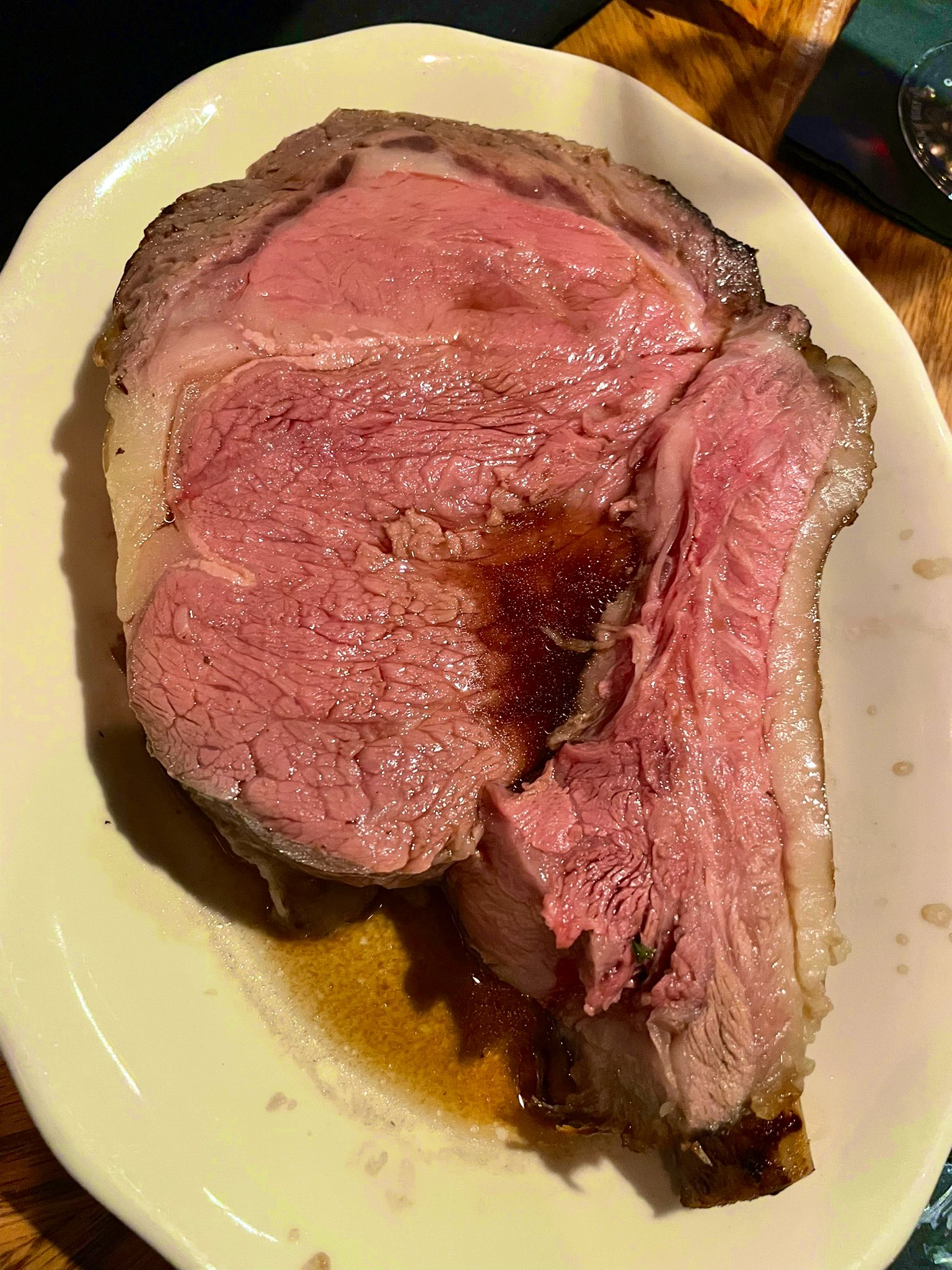
….which appeals to many more for its caveman appeal than general taste. (We’ve always considered prime rib more of a horseradish sauce-carrying vehicle than anything else.)
The new menu is substantially shorter than the multi-paged tome that used to confront you — which featured everything from broiled quail to veal saltimbocca. Thankfully, they kept the toasted ravioli ($14) and oysters Rockefeller ($17), although why they call the so-so escargot ($17) a “house specialty” is anyone’s guess.
And for the 563rd time I will criticize them for not using a wooden bowl for the Caesar salad (yes, it makes a difference), but otherwise tell you it is a beautiful rendition and worth every penny of your seventeen dollars. The wedge ($10) is a blessedly simple version, but doesn’t suffer for it:
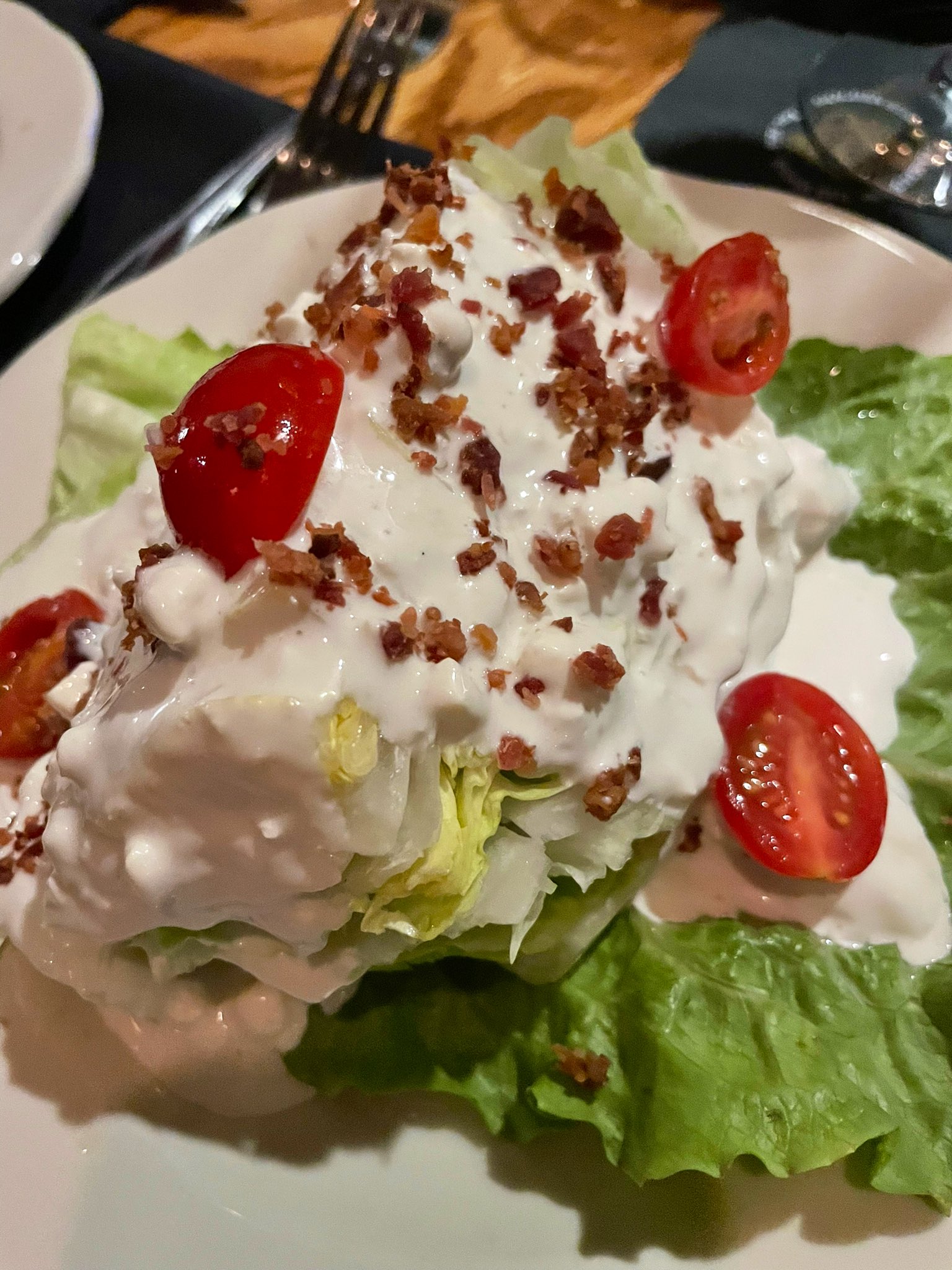
Ooh and ahh over the bananas Foster. Skip the cherries Jubilee.
The Italian food is just as awful as it always was. Thankfully, there is now less of it.
The wine list is short, but well-chosen and well-priced. Lower your expectations and you’ll be well-served, even if the bottles are still too warm and the sommelier service nothing like what you get at more vino-centric steakhouses.
All in all, the Steer has made a dramatic comeback. Covid’s many losses were somehow its gain, and the newest crowd of avid steak eaters has taken to it like Dean Martin to a martini.
A decade ago, the iconic golden steer statue underneath the lettered sign had faded into a yellowish-tan, and was allowed to stay that way…for years. Her(?) name, BTW, is “Betsy”. This stood less as a metaphor for the Steer’s decline, and more as a direct signal advertising the fact. And it made us sad every time we drove by.
Now Betsy gleams bright and lustrous, trading on the past but looking to the future, a mere stone’s throw from the Las Vegas Strip, but competing with it just the same. Long may her golden hide shine.
Our last dinner for two came to $260, including tip. An earlier dinner (where we ate the entire menu) was covered by generous friends who have the pocketbooks to match their prodigious appetites.
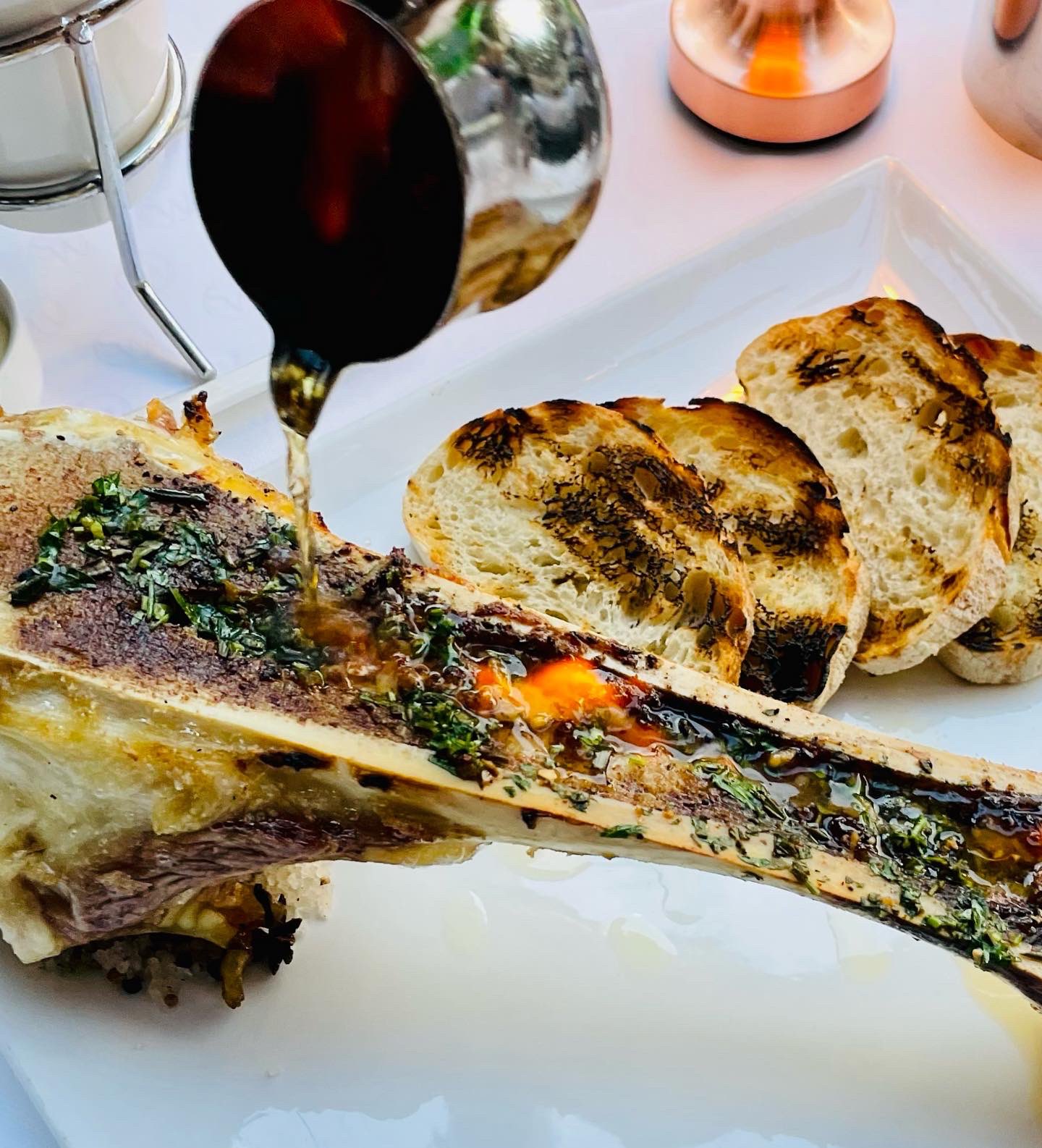
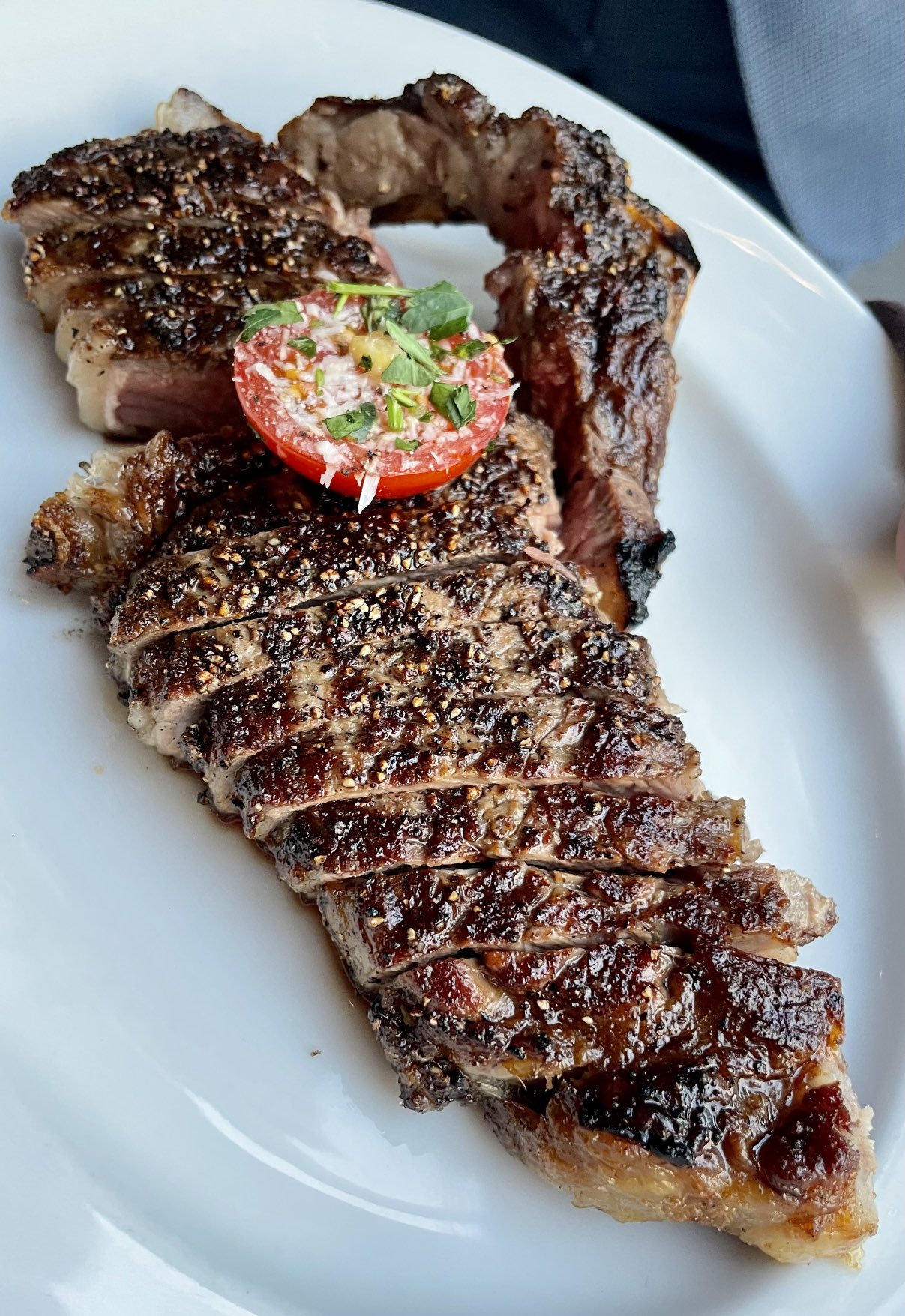

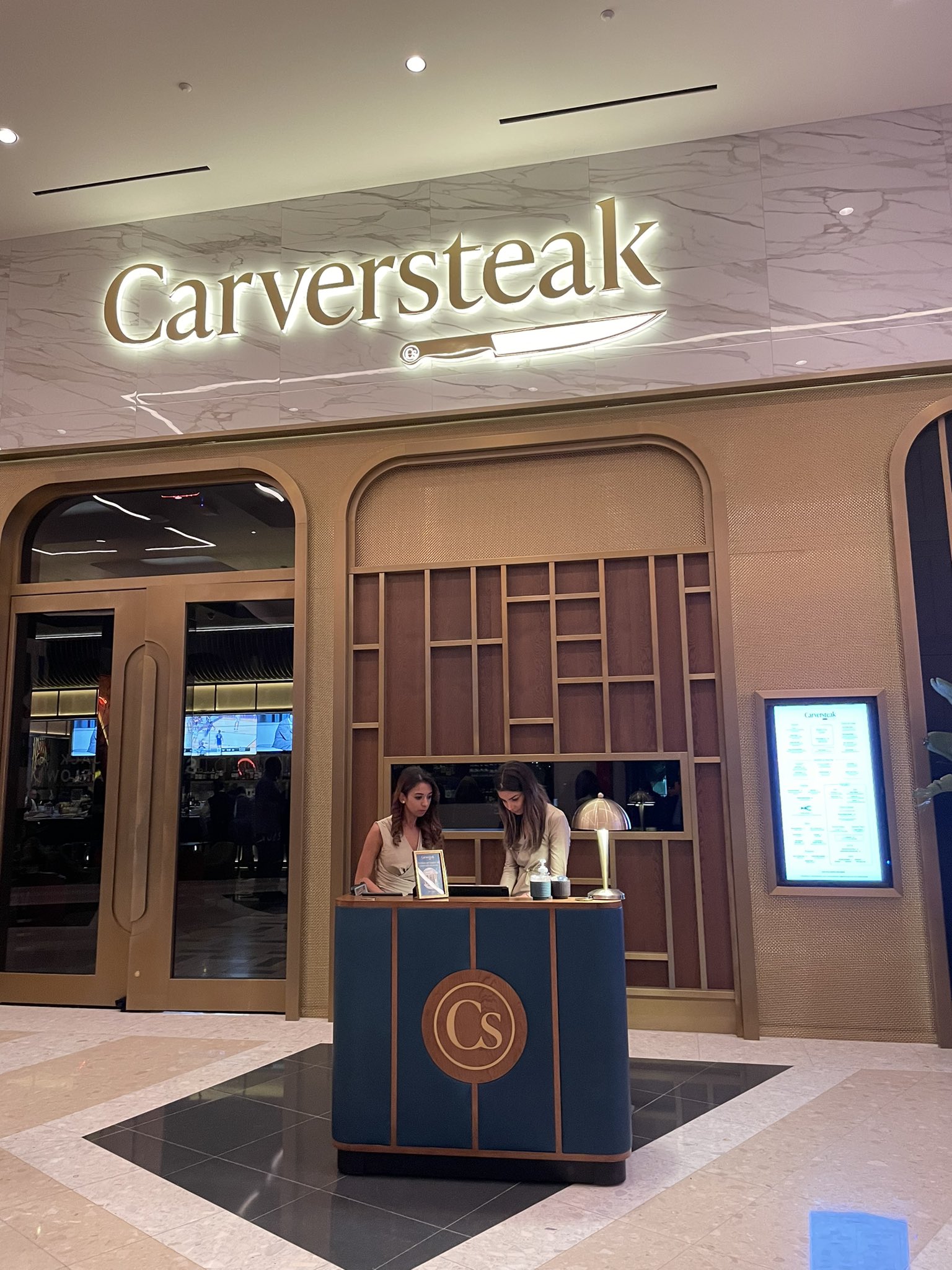
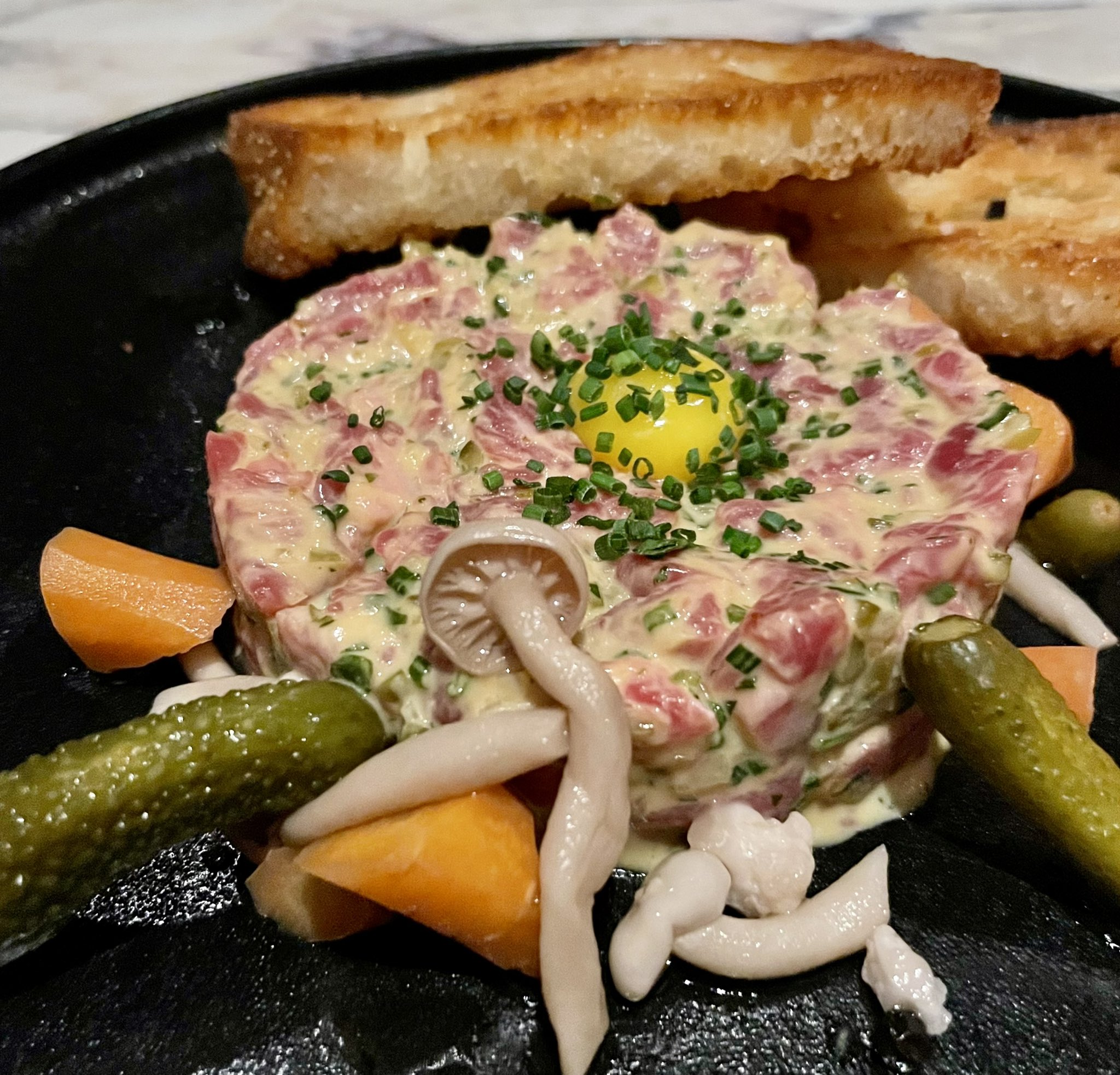

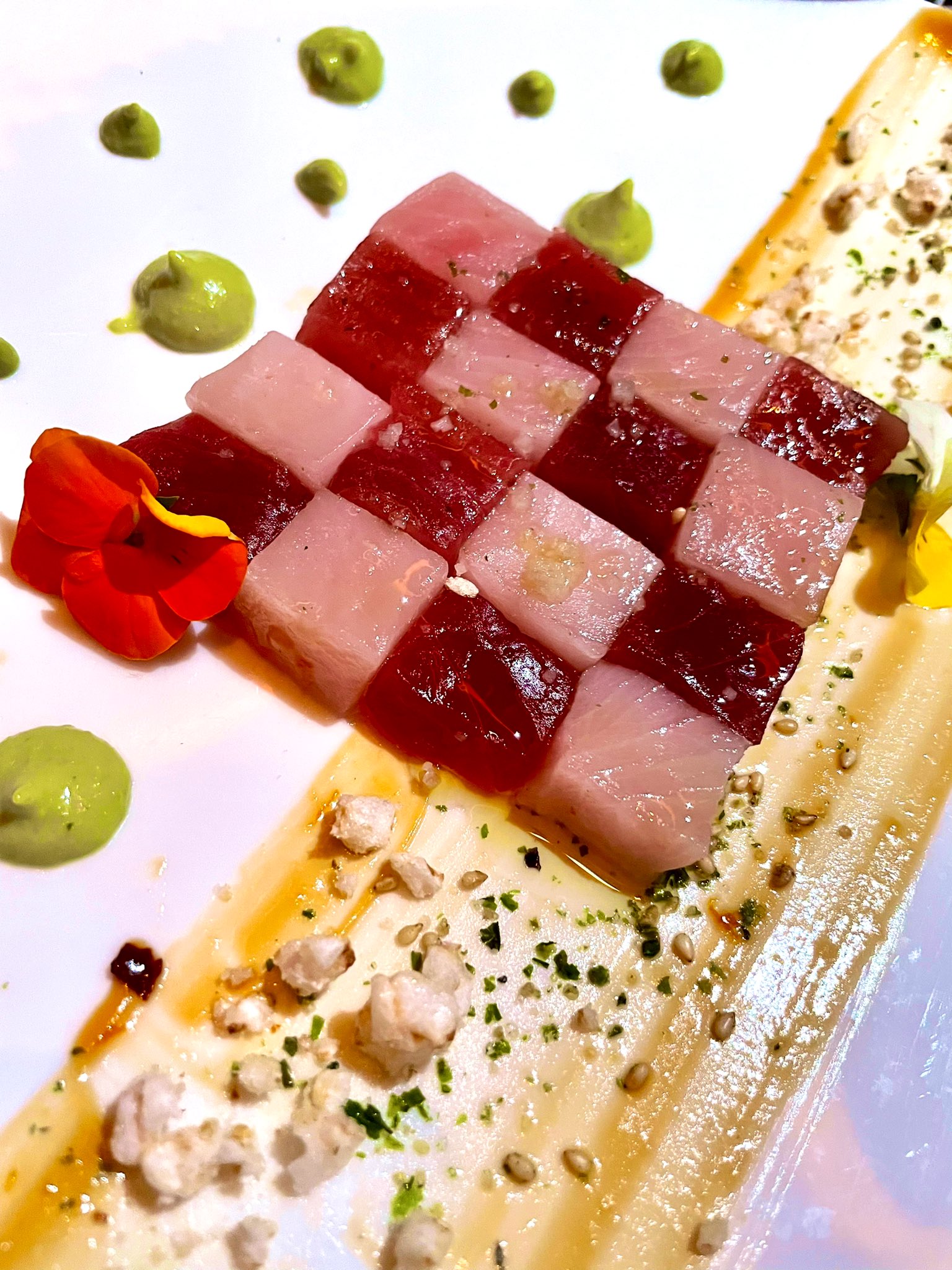
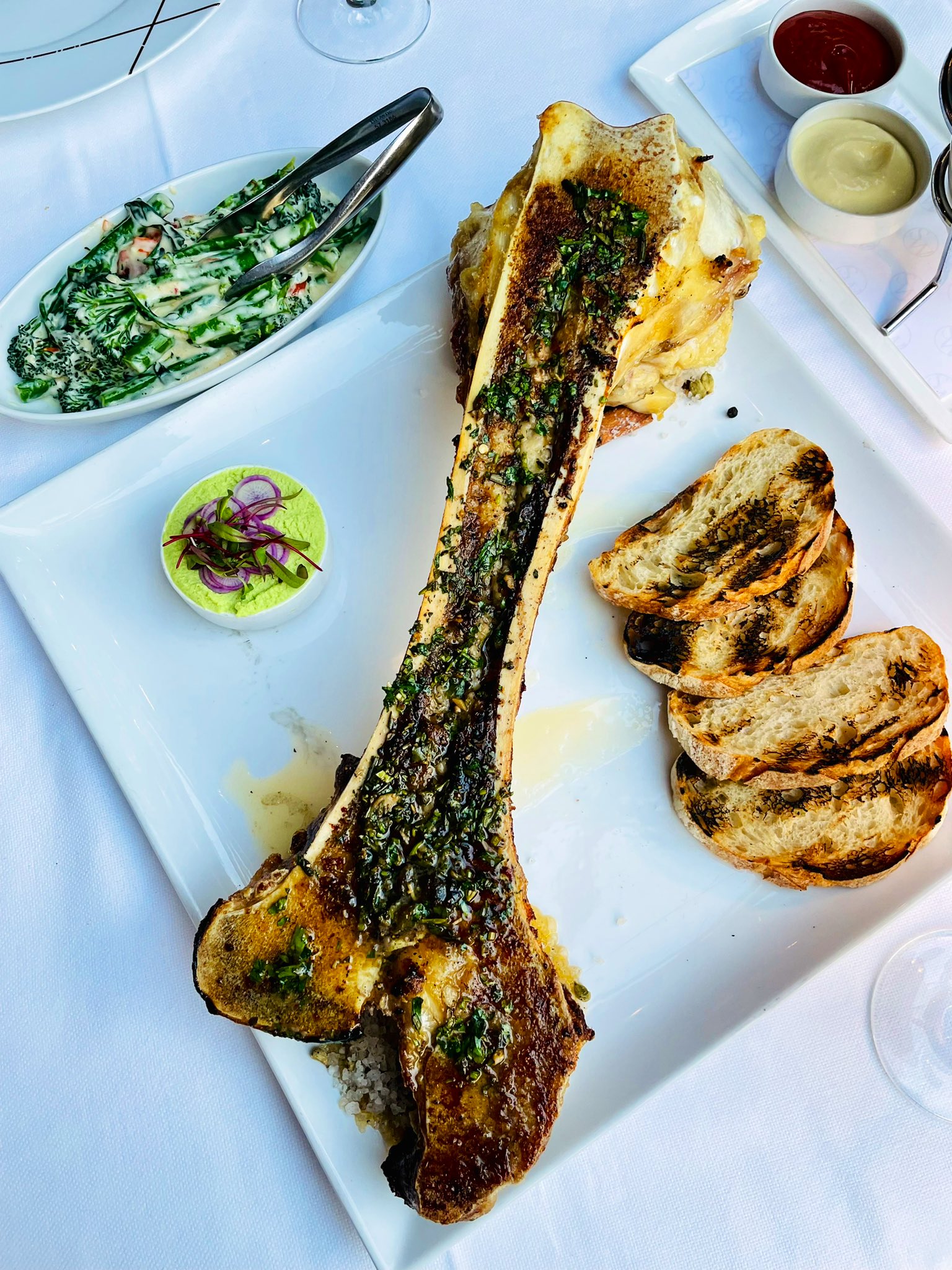

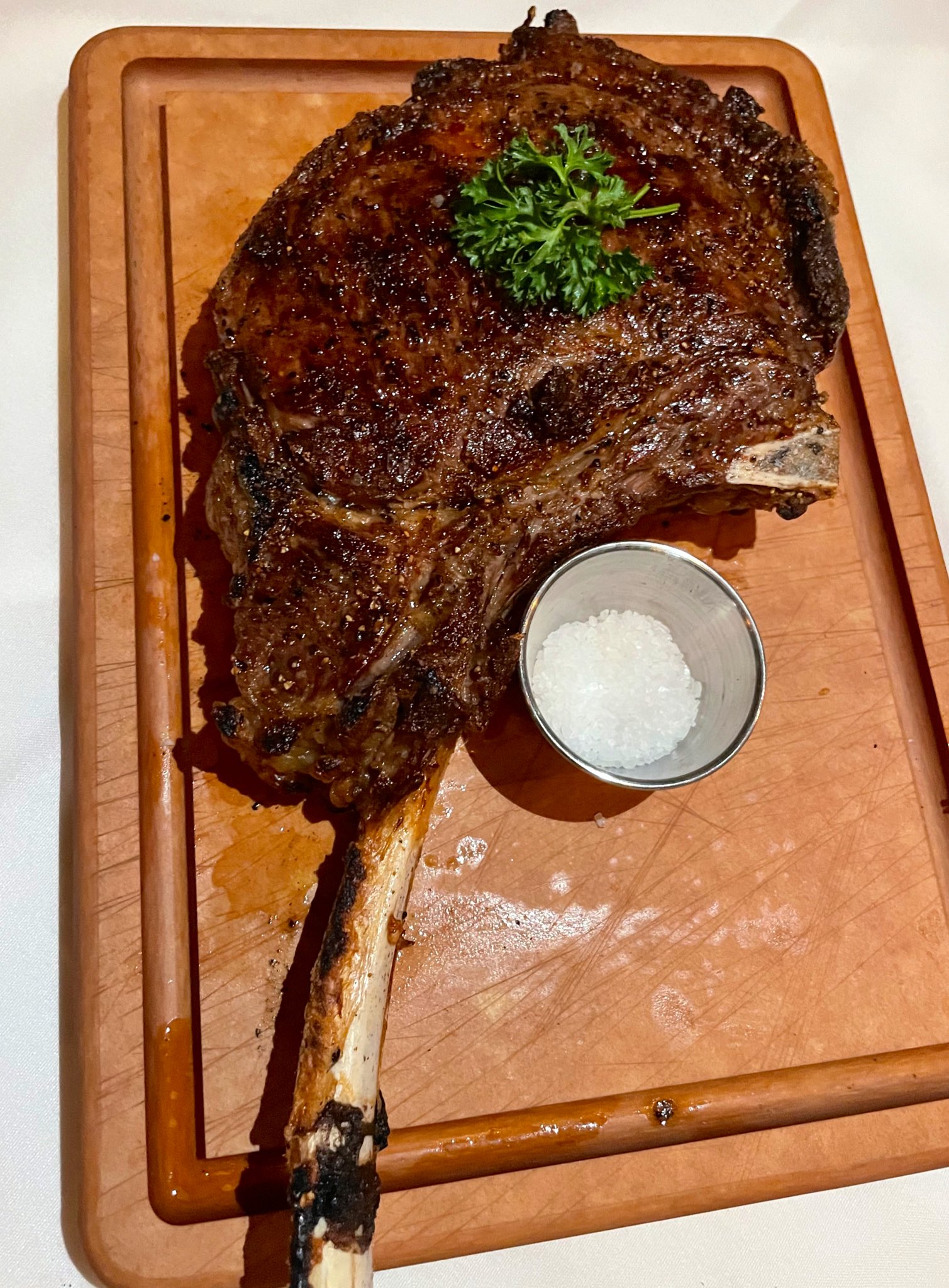
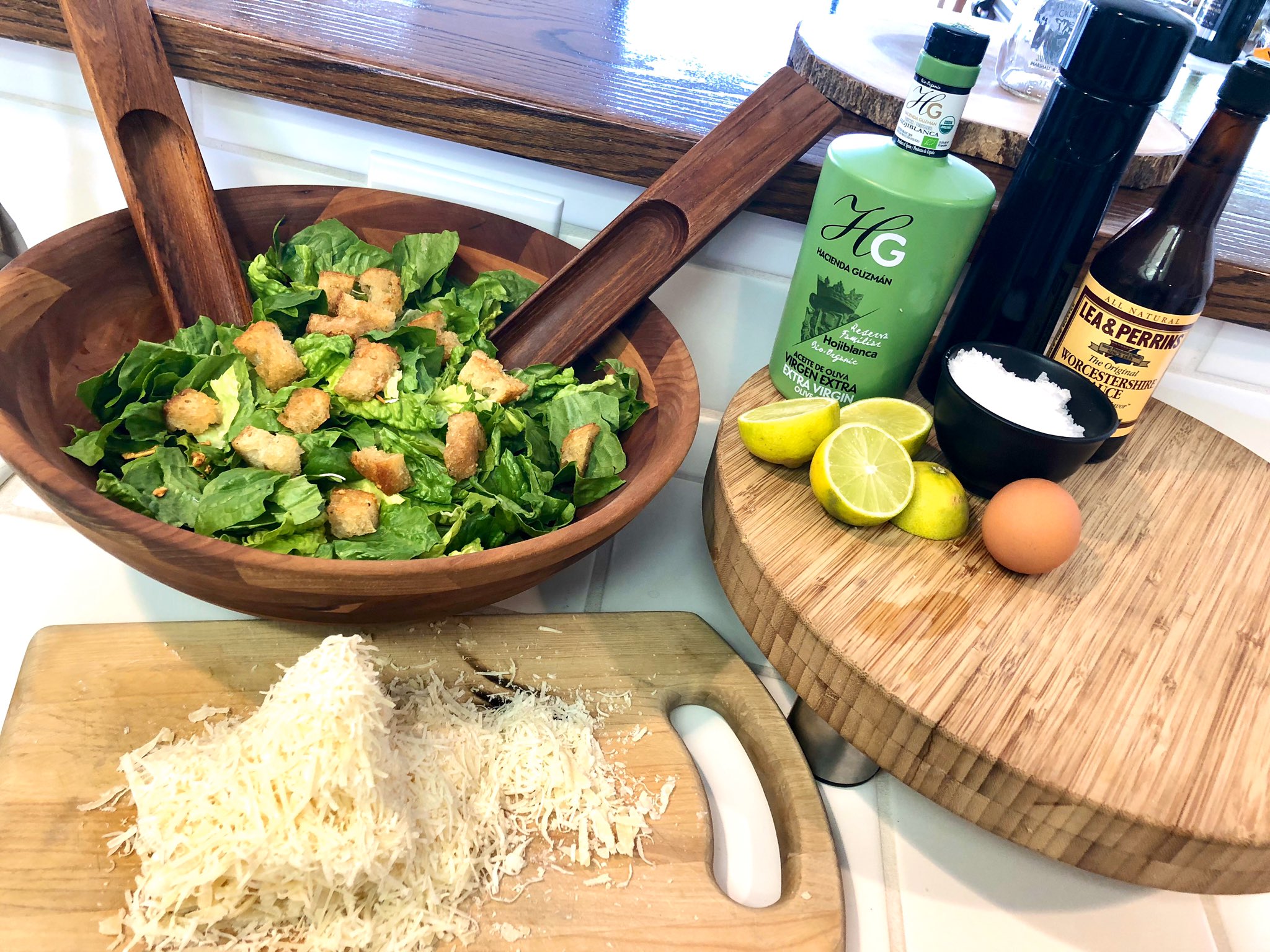
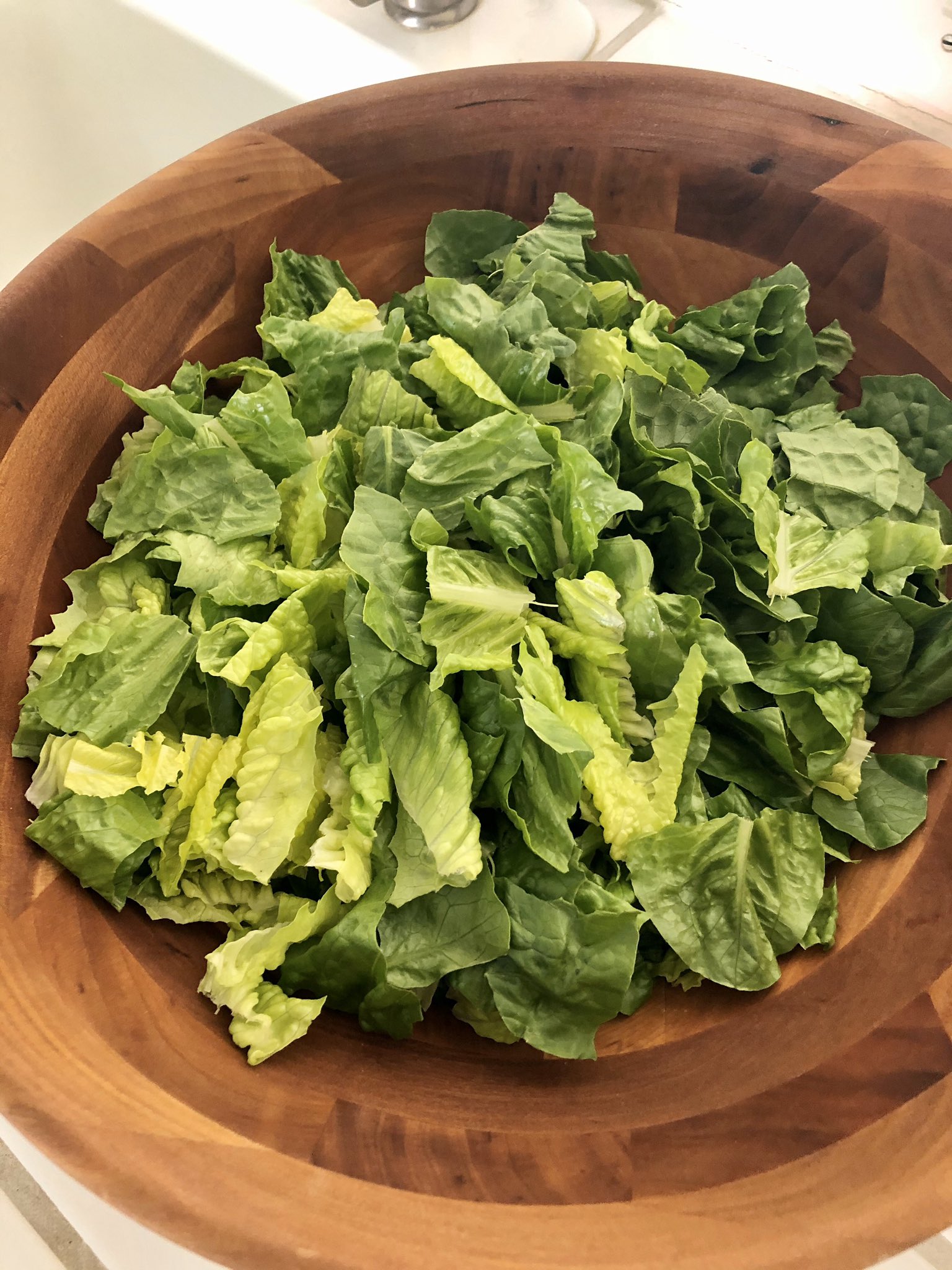 (It’s the wood that makes it good)
(It’s the wood that makes it good)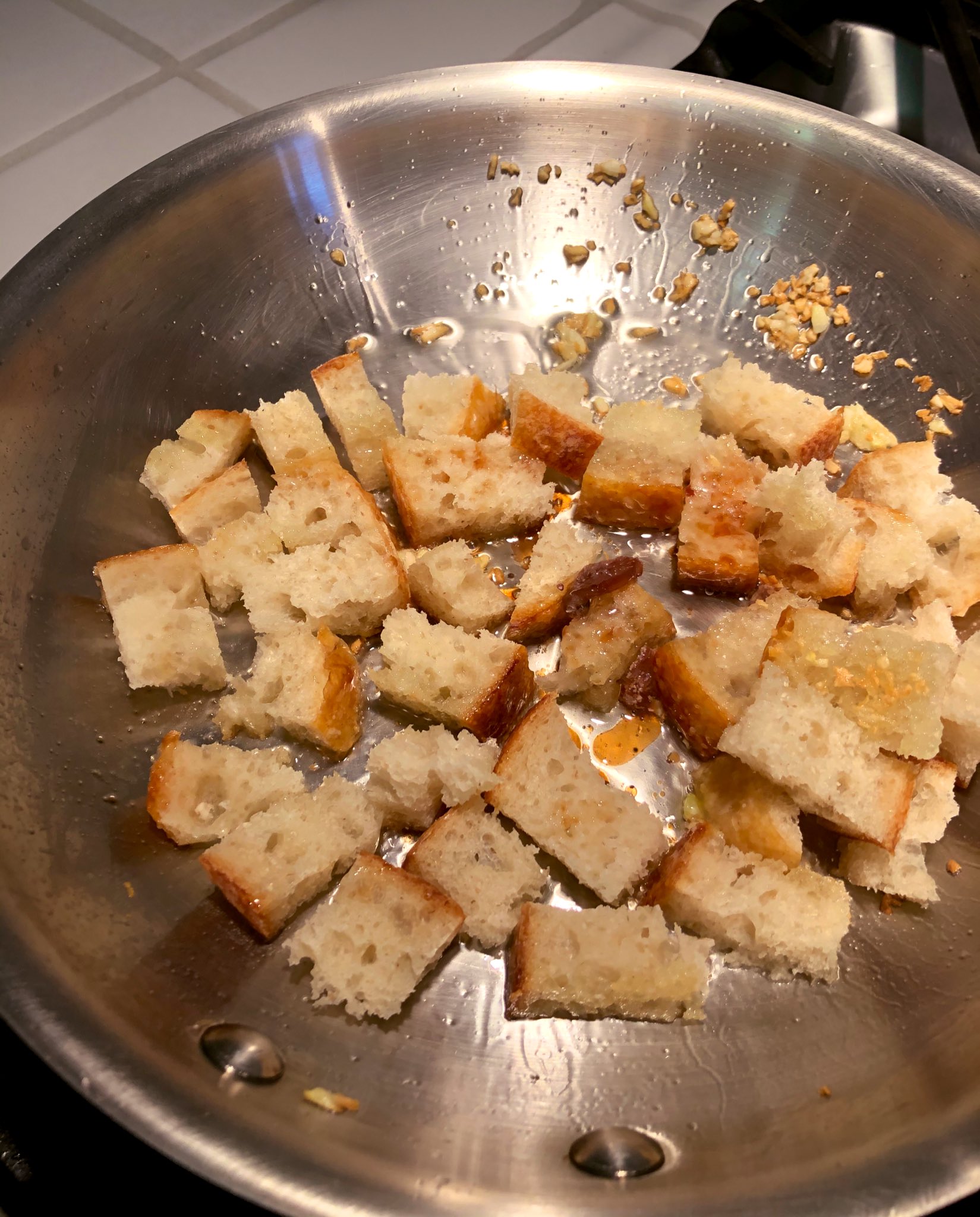 (What does a great salad rest on? A crouton!)
(What does a great salad rest on? A crouton!)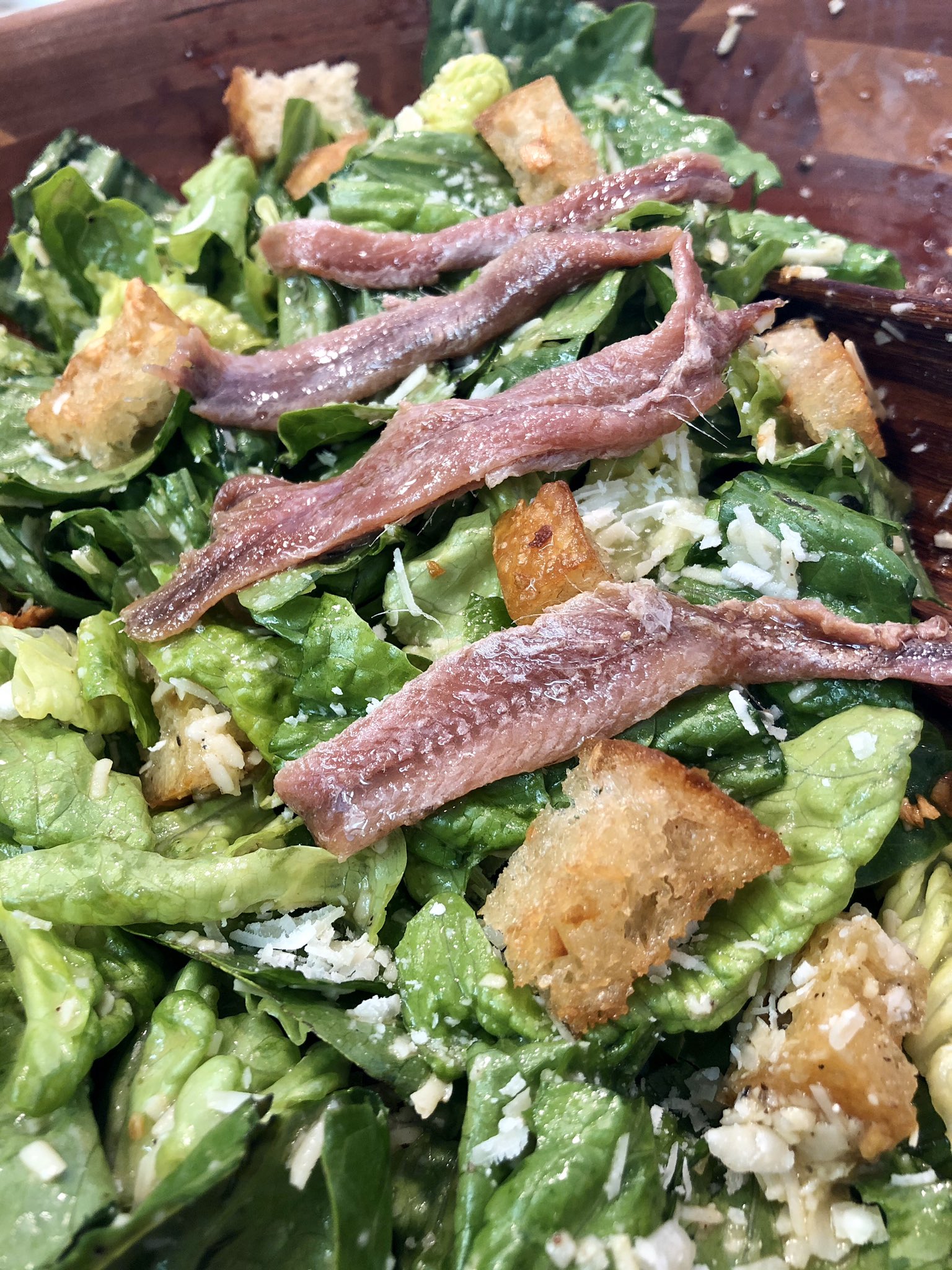 (Sofishticated)
(Sofishticated)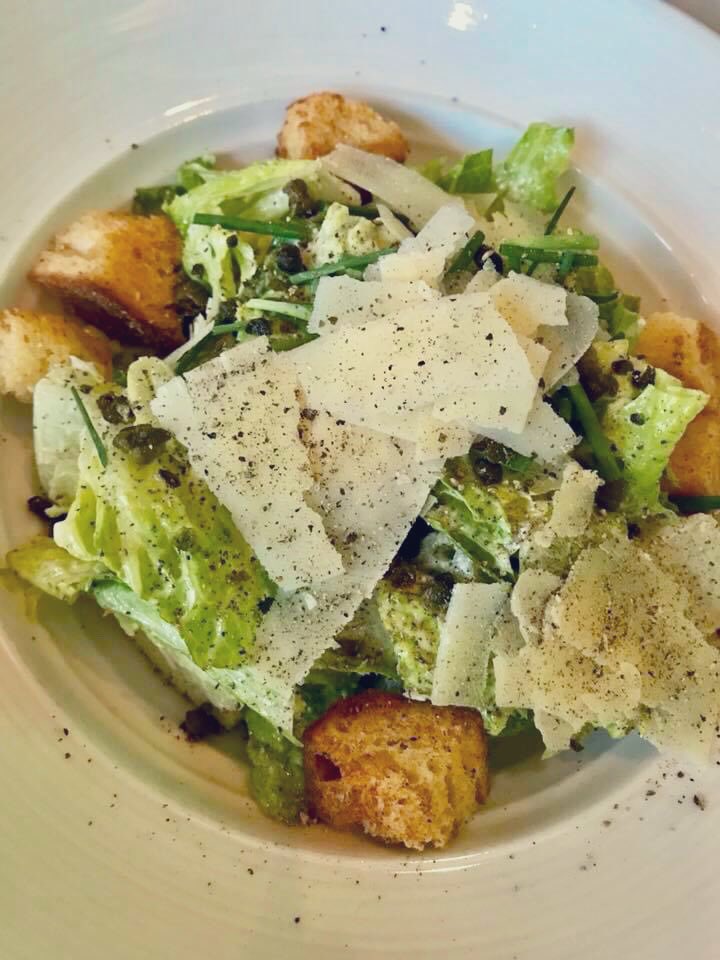 (All dressed up and ready to dance on your tongue)
(All dressed up and ready to dance on your tongue)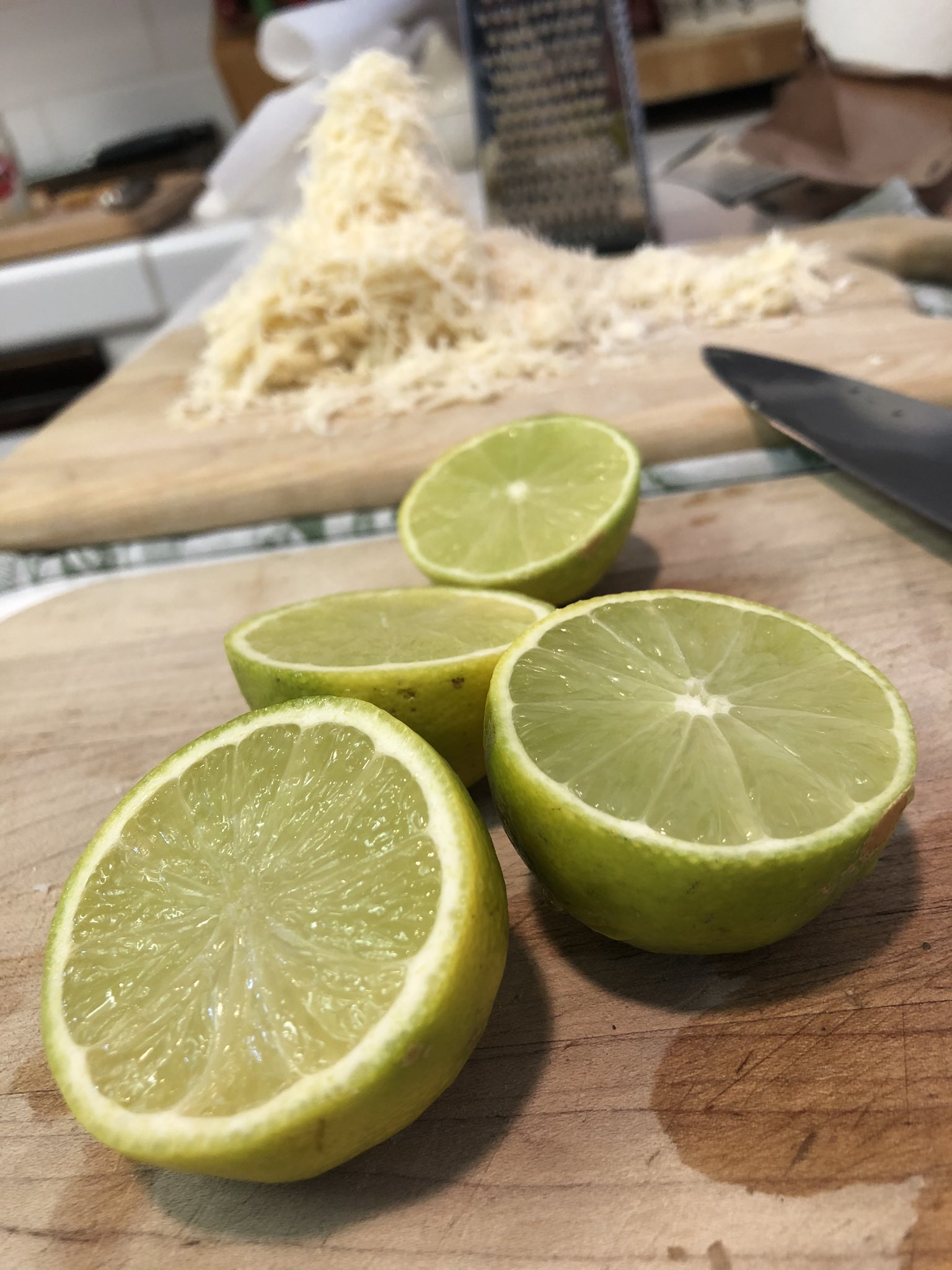 (Sublime)
(Sublime)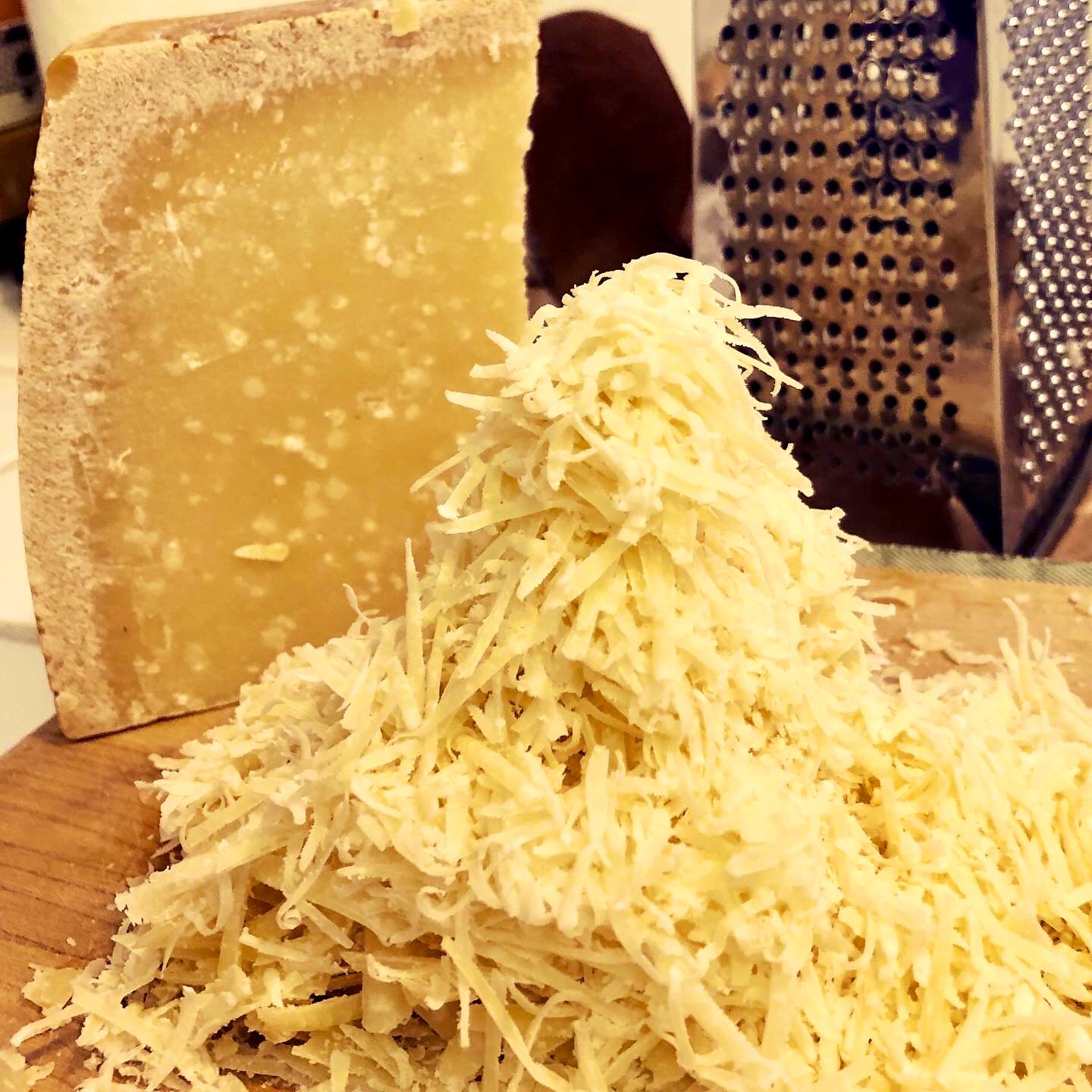 (Old Parm is the best Parm, but precious)
(Old Parm is the best Parm, but precious)